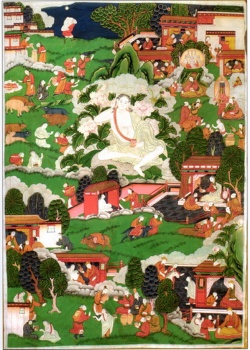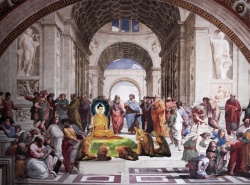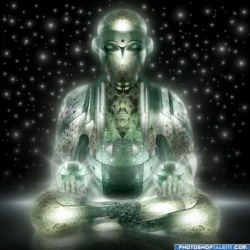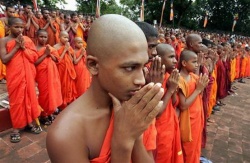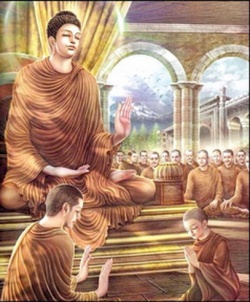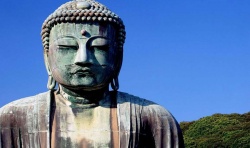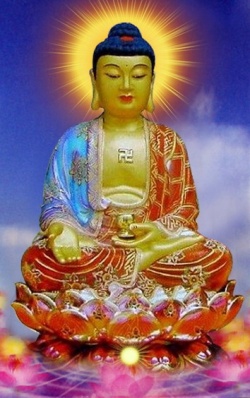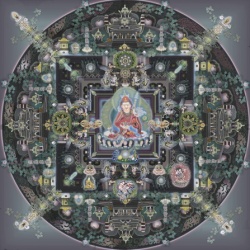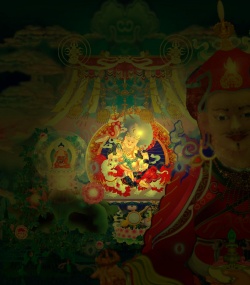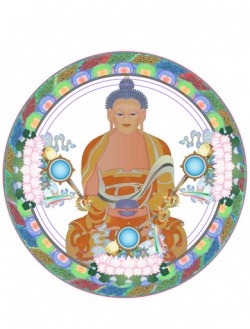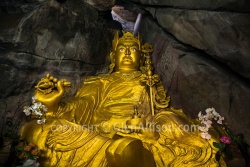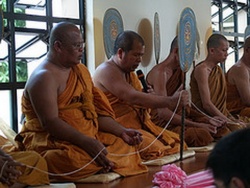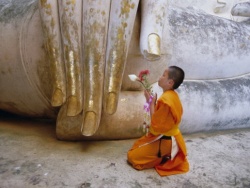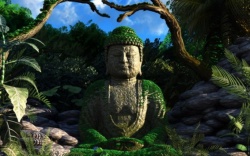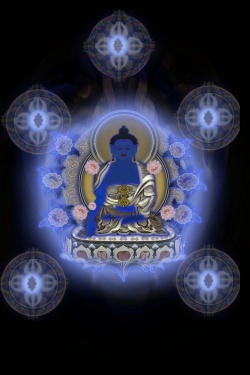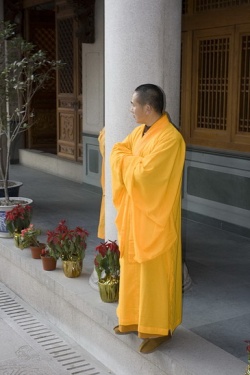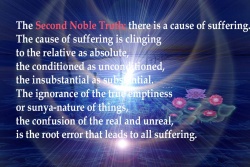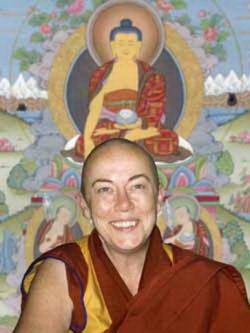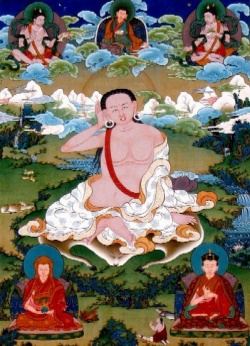The Scientific Outlook Of Buddhism
By Wang Chi Biu
English Translation By P. H. Wei
Introduction:
Buddhism, that oldest world religion, is generally misconceived to be a blind faith. As seen from its outward appearance, really it is painted with a strong religious color. To a non-Buddhist, who sees the golden image of Buddha, and hears the chanting of Sanscrit Sutras and the clinking of the bell, Buddhism is nothing but idolatry; in view of their passive life, Buddhists of the Order are said to be "social parasites". However, on the contrary, whatever is expounded in Buddhism, down to every minor matter, is based on the Teaching of Buddha. Indeed, some of the Buddhist principles are too profound to be easily explained and understood by the lay people, except those of high intellect. Without making a serious effort to study the issue in question, those who say what others say, and believe what others believe, that Buddhism is a superstitious faith, betray not only their ignorance of its fundamental principles but also their lack of common sense and understanding; therefore, in regard to Buddhism, what they say and what they believe cannot but be blind and untrue.
Depending in what sense Religion is defined, Buddhism may be called Religion or non-Religion. If religion refers to Monotheism or Polytheism, then Buddhism, being non-theological, is no religion at all. If religion, broadly defined, refers to some School of Teaching, Buddhism in that sense may be said to be in the same category as Confucianism and Taoism.
In the wake of the remarkable development of modern Science, the monotheistic and polytheistic religions of the world are open to scientists’ attack rather helplessly, but Buddhism stands out as unique exception to this. It is because the more advanced is Science, the more and the better is Buddhism understood. In the meantime, in parallel to the stupendous scientific achievements of this age. Buddhism spreads more and more to the world. In China, at one time some engineers and scientists were not only devout Buddhists but also conversant with Buddhist Scriptures. This is an eloquent proof that Buddhist theories can be tested and corroborated by science. In reality, the more learned the scientist is, the easier and the better can he comprehend the difficult Buddhist terms and the profound theories of Buddhism. Thus he would come to realize that whatever phenomena, physical or psychical, as explained by Buddha, far from being superstitious, are all based on Reason and reality only. In the light of this understanding, the writer was prompted to present to readers "The scientific Outlook of Buddhism."
Chapter 1
Buddhism is Absolutely a Rational Religion
Buddhism is an experimental intelectual product, like science. In view of this similarity between the two, it may be safely assumed that rather by science, than by Philosophy, Political Science, Economics or Literature, Buddhism can be better understood. Inasmuch as science has broken down the walls of ignorance and liberated mankind from the fetters of delusion since thousands of years ago, Buddhism also has made its significant contribution to humanity towards the same end. Some salient characteristics of Buddhism may be mentioned in the following to show where it is established absolutely on rational basis.
(A) To Remove Ignorance
Usually we are subjected to various sorts of illusion in daily life and unless detected by reason and awareness, they may remain with us and lead us to make errors once and again. For instance, in the old days it was generally held that the earth was flat, square and standing still while the sun was in motion; later this conception was refuted by scientists and proved fallacious. Again, eclipses of the sun and the moon were looked upon by the ignorant people to be something very mysterious, but today not only we are familiar with the sun eclipse to be caused by the moon and the moon eclipse to be due to the shadow of the earth, but when such incidents may take place can be known precisely by mathematical calculations. In Geometry many examples of illusions may be found. If two lines of same length are put in parallel with each other, with bracket sign appended to both ends of each line, likely we would be under the illusion that one line is longer than the other. From this, it shows that usually we cannot tell exactly the length of a thing merely by our eyes. Again, as pointed out by astronomers, it is fallacious to assume that those stars before us are existent, because they are so far from the earth that the distance between the two may be calculated in terms of Light Years only (each Light Year calculated by this formula: 300,000 miles per second multiplied by the number of seconds of one Calendar Year), thus some of those stars may be as far away from the earth as several ten Light Years; in such cases, most likely what we see are not stars but only their lights issued as far back as several decades ago and, where they are now, scientists can hardly know. Again, in our general conception, tables, chairs, cups, etc., in the house are solid and motionless, but according to physicists, the atoms of those hard objects are similar to the Solar System, with electrons rotating around atomic nuclei at the rate of Light Speed and also with adjoining atoms vibrating all the time, thus considerable spaces between electrons and atomic nuclei, and those between the adjoining atoms are left empty to a large extent; of course, such interior phenomena of those things and their outward appearances are entirely different from each other. This shows that owing to the illusion of the eyes, the reality of everything cannot be correctly perceived, and it is only by logical inference that illusion may be rectified and correct perception may be possible.
In the pre-science days many errors of illusion were rectified by Buddhism. Refuting the old Chinese saying, "there are no two suns in Heaven", the Sutra says: "In the Great Trichiliocosm, there are as many as ten billion suns." This statement, astounding as it is, is in accord with Astronomers’ discovery that all those densely-clustered stars in the space and everyone of them are affiliated with the Solar System. Whereas in the Chinese poetry the moon is described "full" of "partial", the Sutra says the moon is "bright", "clear", "dim", or "dark", and this is not only free of visual illusion but also in line with the scientific theory of the moon reflecting on the sun. Again, one who is ignorant of Biology would assume that the "self" is the sole possessor of the body, but, in fact, inside the body, there reside innumerable cohabitants of living germs. As far back as 2500 years ago, Buddha made this assertion: "Human body is but a swarm of worms which may be enumerated into eighty kinds." (Refer to The Secrets of Remedy for Chan Ills Sutra). In the Sutra not only those worms are differentiated by their specific names but also their behavior and activities are described in details. Again, the Sutra says: "As seen by the Buddha, a drop of water contains 84,000 germs." In those prescience days when the aid of scientific apparatus was nil, it was exceedingly difficult for Buddha to make his exposition of this scientific truth understood by his people, notwithstanding their implicit confidence in what he said of himself in the following words: "The Tathagata speaks the truth, speaks in concrete words, speaks of reality as it is, speaks no lies and no contradictions." Of course, those biological facts, revealed by Buddha, can be easily verified by science today.
Before Algebra was introduced in schools, people had very imperfect knowledge of Mathematics; apart from integrals, they knew nothing of negative and zero, and still less, the Imaginary Number. In contrast, Buddhist conception of everything is complete and all-inclusive. To illustrate, when the body is in touch with a thing, there is the feeling of Touch, and when it is not, there is the feeling of Non-touch; if one is used to be unaware of the latter, he would become indifferent to the former as well. To classify feelings of Touch and Non-touch may be said to be similar to the numbers of Integrals and zero in Algebra. Again, in Buddhism, sensation of pleasure, sensation of pain and neutral sensation (neither pleasure nor pain), are as differentiated from one another as integrals, negative and zero are in Algebra. Besides "good" and "evil", there is the "indefinite" which is neither good nor evil. All this shows that Buddhism is complete and all-embracing, and in some respects, apart from being in accord with the scientific spirit, is above the common sense.
The Theory of soul is repudiated by both Buddhism and Science. The reason why believers upholding this theory is this: as human body is made of flesh and other material things, all of which are without consciousness, the need of a conscious being to be its master is obvious, same as a motor car in need of a driver. According to this theory, when one is alive, the soul is inside the body, but at the time of one’s death, it departs from the body. Apparently, this sounds plausible, but if tested by Logic or Hutuvidya, the Science of Cause, its fallacy is perceived at once. Let us ask this question: Is the soul material or immaterial? If it is a material thing inside the body, why has it remained unknown to mankind without being discovered by Science of Anatomy even to the present day? The assumption that it leaves the body after one’s death is illogical, because no material can move by itself; and if it is sent out by the heat of the body, it should be found around the body. Again, since both the soul and the body are material things and both of them are without consciousness, to say that the one needs the other to be its ruler is utterly pointless. Therefore, to say that the soul is material is a fallacious statement. On the other hand, to say that it is immaterial is also fallacious, for if it can move in and out of the body, it is no longer immaterial.
Now that the concept of soul is refuted by Buddhism, we may ask, "What is THAT which rules over oneself during one’s lifetime and is subjected to reincarnation after one’s death?" Here is Buddhism’s answer: THAT may be expediently called either Consciousness or Buddha-nature and is the Essence of everything; it is immaterial and formless, neither inside nor outside the body, neither entering nor departing from the body. Consciousness is Essence contaminated with material craving and passionate vexation, and Buddha-nature is Essence pure and undefiled; in reality, Consciousness and Buddha-nature are but two aspects of one substance. Of course, Consciousness or Buddha-nature is essentially different from the soul, which is said to be of material form, abiding inside the body and capable of moving in and out. Despite that Consciousness or Buddha-nature is without these physical attributes of the soul, nevertheless, if and when conditions are ripe, it may transform itself into a material form to enter or to depart from the body. In view of this, it is said to be neither material nor immaterial. Now to return to the above question. Without being able to give any answer at all, the scientist merely says arbitrarily, "There is nothing like that." Buddhism tells us, however, that it is only by direct apprehension of the reality and by self-experiencing, as resorted to by Buddha, that truth and illusion may be perceived and the good and the evil may be clearly discerned; in the meanwhile by the various Dharmas of cultivation, we would be able to verify truth by ourselves, after the manner of Buddha’s self-experiencing.
Indeed, Buddhism and Science are two brilliant lamps of the world, and it is by their illuminating power that ignorance and superstition would be eliminated, biased views and dogmatism would be eradicated and infinite progress would be made by human beings in exploring human wisdom till the attainment of Supreme Enlightenment. It must be conceded, however, that no matter how progressive and advanced is its development, science is largely confined to the study of material phenomena, but to understand the reality of those phenomena where mind is involved, we cannot but depend on Buddhism, and Buddhism only. For instance, nowhere among those books of Western Psychology can we find such inexhaustive and analytical study of the psychological aspects and reactions of the various sense-organs of human beings as enunicated in the Sastra on the Hundred Divisions of Mental Qualities.
On hearing a musician playing a famous piece of music, not only we can tell its melody by Ear-Consciousness and its tune by Sense-center Consciousness, but various kinds of imagination would stir up and sensation of enjoyment and craving would arise automatically (according to Dharma-laksana sect, in such psychic phenomena the following Mental Associates would be brought out into play: touch, volition, sensation, conception, desire, greed, stupidity and indolence). This case refers to people with musical training. If it is played to someone ignorant of music, the tune and the melody notes are but packages of noises and his reaction would be a feeling of disgust instead of pleasure. Again, to a physicist, music is nothing but a series of air waves with chords and curves of various frequencies (simple harmonic vibrations), and actually this corresponds with the way the eardrum responds to the sympathetic vibration of air waves. According to his conception, on the sine curves there is neither melody from Ear-Consciousness nor there is tune from Sense-center Consciousness at all, and still less, the feeling of like and dislike. In short, the vital fact is often overlooked that whatever differentiations and reactions caused by Ear-Consciousness and Sense-center Consciousness are usually misconceived to be something of the air waves, and without our being aware of our illusion, we are used to say the song is "pathetic" or "beautiful", as if these were the qualities of the song. This shows our greatest error of illusion : [To Perceive the Unreal as Reality). Therefore, Buddhism expounds this fundamental principle that every phenomenal change is made by consciousness only. Let us take another illustration. To one who likes onion, it smells good, and for another person who dislikes it, its smell is repulsive. However, if in reality it is of one smell, it should not vary with different persons.
(B) To Let Go Emotions
To help us discover our various sorts of illusion and to rectify them by reasoning so as to enable us to proceed progressively towards the Path of enlightenment may be said to be the professional work of Buddhism. For this reason, Buddhism is said to be absolutely rational: not only it is unmixed with, but also free of, every sentiment, and in this respect, is completely identical with Science. Though Philosophy is also established on rational basis, it cannot be gainsaid that among those different schools of Philosophy, as far as their theories are concerned, there is no lack of biased views, dogmatism and subjectivity. This also holds true with other subjects of Social Science. Literature and Arts, where sentiment plays the predominating role, and where sentiment is strong, reasoning is weak, this is why, since thousands of years ago the work to make correct evaluation of Literature and Arts has been rather difficult. Feeling and reason usually and mutually counteract each other; when emotion gets the upper hand, reason flies out of the head, and when reason prevails, such feelings as fear, craving and so forth all give way. Parental love is a natural feeling but if it is carried to excess, one would not be able to understand the youngsters and their conduct correctly. Again, if patriotism bursts out for no cause, it would become chauvinistic, fanatic and calamitous. If male and female, desperately in love with each other, are unable to overcome obstructions standing in the way, they would lose their head and do such foolish thing as to commit suicide. In the eyes of Buddhism, all these private and public feelings, because they are overdone, are foolish and blind love, therefore on no account should we allow emotions to get the better of us. Thus, the Surangama Sutra says: "The reason why sentient beings may ascend or descend at the six levels of Transmigration is this: if emotion prevails, they would to go heaven; if there is emotion without conception, they would go down to hell; if there is half emotion and half conception, they would be born as human beings."
The critical attitude of the scientists is absolutely unsentimental, impersonal and with strong accent on the power of imagination. In view of the inadequate visual power of human eyes, we have to depend on our imagination to help us visualize the structure of atoms, the movement of the Celestial Body, transmission of electric waves, and the complicated structures of various scientific instruments. Projective Geometry, for example, is a subject where most far-fetched imagination is required.
In Buddhism a good many Dharmas under the general heading of Ch’an Meditation take to imagination as a means of cultivation. The Five Meditations are a case in point: 1. Meditation on impurity of the body, 2. Meditation on Breathing, 3. Meditation on Compassion, 4. Meditation on Causality, and 5. Meditation on either the six levels of Transmigration of the eighteen Spheres. Besides, there are "Meditative Insight into the Unreality of all things", "Complete and Immediate Meditation", "Meditation on Mere-Consciousness", "Meditation on the Ten Realms", and as pointed by "Meditation on Amitabha Sutra", the Sixteen Meditations. According to the last-named Meditations, some of them are concerned with the principles of Buddhism and some with material phenomena. In the Meditation on impurity, the object of meditation is the structure of the human body, and in "the Nine Meditations", the process of decomposition of the dead body is meditated upon. Of the Sixteen Meditation, the First One is meditation on the setting of the sun at the western Paradise, and if the image can be clearly perceived whether with eyes opened or closed, the meditation would be considered well done. In the subsequent meditations from the Second to the Last ones, the objects of meditations are the people and things of the Supreme Happiness Buddhaland. To practise those Meditations calls for a high degree of imagination and so corresponds with the principle of Projective Geometry. Because he had had training in the study of Projective Geometry at school, the writer had experienced little or no difficulty in practising the First Meditation on the setting sun. This was corroborated by a distinguished Chinese Mathematician, the late Dr. Wong Chi-Tung, who used to practise the First and the Second Meditations with the most gratifying results. At all events, whatever meditation one may practise, intensive training of concentration and imagination is of fundamental importance on no account should such feeling as craving, fear, despair, disgust, etc. be allowed to enter into the meditator’s mind, otherwise one would run the risk of going the Devil’s way.
(C) To Establish Right Belief
"Buddhism is not a superstitious faith but a rational belief derived from wisdom", said the late Mr. Liang Chi-Chao, a veteran celebrated Chinese scholar. By Buddhist belief it is meant that the essence of a theory, though not yet verified by oneself, can be inferred by reasoning to be valid truth; in this sense it is at variance with the beliefs of other religions which enter on entirely different objects. What Buddhists believe is this: because Buddha-nature is inherent in every one, all sentient beings can become Buddha; Buddha-nature may manifest itself in everything, and neither becoming nor annihilating, is fundamentally pure and intrinsically immutable; inasmuch as every thing or every incident is dependent on combined causes and conditions, it has no self-nature of its own, is nothing but manifestation of the mind and is subjected to transformation by consciousness. The fundamental objective of Buddhism is to attain Complete Perfect Enlightenment, which is Wisdom evolving at the highest level of mental development, and also is the most progressive and the highest evolution of mankind. However, the belief held by some religion that God, the Omnipotent, is the Creator and "Father" of all humanity, and as such, has absolute authority over every one and should be absolutely obeyed by everyone, is in striking contrast with the Buddhist Belief and in effect, cannot but detrimentally undermine one’s own individuality, one’s own freedom of will and also the freedom to evolve one’s potential wisdom. As far as belief is concerned, evidently there is a world of difference between Buddhism and other religions. Buddha tells us the fundamental message: "Buddha’s virtues and Wisdom are immanent in all of you. This cannot be verified by you, because you are defiled by the Five Desires and egoistic thoughts; consequently, as long as you cannot deliver yourself from the bondage of delusion, you would be subjected to endure infinite sufferings." Once this fundamental truth that we are at par with Buddha is realized, a sense of self-respect would be enhanced, and every effort to practise spiritual cultivation to attain Complete Perfect Enlightenment would be exerted diligently. On the contrary, some religion has this to say: "God is our Creator, and has the power of rewarding or punishing us, therefore we should serve him like a master, and if we are absolutely obedient to him, we would be called his worthy children, and, after death, would be blessed to go to the Paradise." Granted ahtat as a reward for one’s own good deeds, one would go to the Paradise, but as long as he remains to be absolutely obedient to the Paternal Authority in question, how can one enjoy true equality and true freedom over there?
Apparently, intelligence – not belief – is stressed in learning science, but on closer examination, we can see that belief is an important requisite for studying science. The amount of lab. work of Physics and Chemistry, compared with the number of untested theories and principles, is said to be in the ratio of 1 to 1000, now the question arises: regarding those untested theories, should we first experiment with every one of them before we take for granted that they are all valid?, or, under the circumstances, should we accept all of them to be valid before testing them, one by one, ourselves? In fact, we can only choose the second alternative, for two reasons: firstly, because we know well enough from our study that not only those theories can stand to reason but also they are applicable and experimental; secondly, because in the history of science, neither a theory nor a scientist has ever been found to be a fraud, thus we have implicit confidence in the validity of those untested theories. From this, it can be seen that Belief is also essential to scientists: if a theory is deduced from commonly recognized principle, it should be accepted as valid. Again, as long as it is applicable to the present conditions, the validity of a theory holds good, unless contradicted by new discovery. Also, scientists firmly believe that all phenomenal transformations are subjected to the operation of the Law of Cause and Effect, and that none of them is uncaused, or cause by a Creator, or controlled by an unseen Power at all.
Similarly, Buddhists establish their belief in the same way. If, under critical study, no Buddhist principles are found to be illogical, impractical and deceptive, their validity should be accepted, despite the lack of their verification. Take the question of Buddha-nature, for example. Although in most cases Buddhists have not experienced what Buddha-nature is, nevertheless they all accept the validity of this theory, because of their belief in Buddha’s words, so the way to tackle the question of Buddha-nature is this: belief first and to follow up with practice till Buddha-nature is realized by self-experiencing. Once Buddha-nature is verified by oneself, it is immaterial whether to believe it or not. Again, the truth that one eats to satisfy hunger is known to everybody and needs no belief or persuasion. However, if some say that some kind of vitamin pills appease hunger, we should not believe then until we have learnt such effects of the pill from books or from their own experience. If no pill is available on hand or if no one has ever tried it, belief is still possible provided there are good reasons for believing. But to say that one would not go hungry merely by watching others eating, but without eating oneself, is so nonsensical that no amount of reasoning can dismiss its absurdity. Similarly, what some religionists say that thousands and thousands of sinners would be redeemed by a martyr’s death is exceedingly difficult to believe, and to believe it is nothing but superstition.
The Research Spirit of Buddhism
Buddhism teaches us not only to believe, but also to doubt, thus the Sutra says: "The greater doubt, the greater understanding, the less doubt, the less understanding, and no doubt, no understanding."
If a theory can be explained verbally or in writing, it may be believable; if it is inexplicable or inexpressible, it is doubtful. According to Ch’an Buddhism, once you are in doubt, keep it up incessantly with full attention, until at the advanced level of development, your mind is unobscured and completely clear. The research work of Buddhism is extraordinary and broadly extensive for it covers both the material and psychological phenomena of the world. Ordinarily people have the notion that scientists are the most critical people who ask mostly "Why" questions. Actually this is not ture, for scientists are not so much concerned with "Why" as with "What" questions; it is noteworthy that nowhere the bold question-word "Why" may be seen so oftentimes as in the Buddhist Texts. For example, while as Electrical Science says that particles of iron, if arranged in good order, would produce magnetism, it never asks, "why is magnetism produced?" or "why would particles of copper, if systematically arranged, not produce similar effect?" Again, science tells us that water boiled at 100 degree c. would turn into steam, but it does not explain why water should absorb the latent heat before it becomes steam nor would it ask "why is it possible for latent heat to be dormant in the steam?" Regarding Newton’s discovery of the gravitation of the earth, so far, there is still no answer to this question: "Why is the earth in possession of the gravitational force?" In view of the fact that even on material things, numerous "Why" questions have been left out by science unanswered, nor have scientists ever attempted to discuss them openly among themselves, therefore, to say that science has covered practically all the "why" questions about the phenomena of the world and that scientists have satisfactorily dealt with them all is utterly untrue. Buddhists, however, like a lion wounded by an arrow, are wiser and more courageous, for not only they would cure the wound, they would also find out who shot the arrow and why he did it. In dealing with every question, Buddhism is on the look-out for the cause; in other words, Buddhism raises the bold question "Why" every time without fail. If the vital question of life and the universe was confined to material phenomena alone, never could we arrive at any satisfactory solution at all. Therefore, it is only by studying both the spiritual and material aspects of the question that we may tackle it in the right way. Now we can see that as far as the spirit of research is concerned, science is incomparable to Buddhism.
(A) Research Methods
In science there are two research methods of Logic, namely, Induction and Deduction. Induction is to discover general laws or commonly accepted theories by inferring from the phenomenal change of a particular case or thing. On the other hand, Deduction, a priori reasoning, is to infer from general truths and proved theories to arrive at a particular theory or conclusion. Although scientists take every care to work out their experiments by these two methods, nevertheless, some conclusions reached by deductive reasoning are not absolutely reliable. For instance, in Newton’s Law of Universal Gravitation, the speed of movement of things was left out. Also, in the old Physics, two Laws, "Conservation of Matter" and "Conservation of Energy" were repudiated by modern science because of their fallacy. However, Mathematics, based on Deductions, are free of those errors; for in Maths. Although the way it infers general truths by deduction is different from the Buddhist Method of Direct Inference by Wisdom and Pure Mind, nevertheless, it is in conformity with direct apprehension of the reality of the world. Hence, in the eyes of Buddhists, all the theorems and conclusions of Mathematics are correct and true.
In comparison, the research methods of Buddhism are more rigid than those of science. According to Adhyatmavidya (a Treatise On the Inner Meaning of Buddhism), it is only by eliminating both vexation-and-passion-hindrances by wisdom and pure mind that the reality of all mental and physical phenomena may be clearly perceived. In order that this vital question may be more easily understood, Buddhism offers us the aid of Hetuvidya (the Science of Understanding the Cause), which incorporate Preposition, Reason and Example in tri-form of reasoning; the method of reasoning for the second form is Direct Inference and that for the third form is Comparison of the Known and Inference of the Unknown; both of these methods not only are in line with the logical reasoning of scientists, but are also accepted as general truth. Identically, the tri-statement formula of Hetuvidya corresponds to the three syllogisms of logic but in reverse order. In Hetuvidya, the first statement is the preposition, the second is the cause and the third is examples subdivided into (a) analogy and (b) opposite; in Logic, the major premise comes first, then the minor premise and the last is conclusion. For illustration, two charts are given below:
A) The Chart of Syllogism In Logic
1. The major premise: All metals conduct electricity.
2. The minor premise: Aluminum is a metal.
3. Conclusion: Therefore aluminum can also conduct electricity.
B) The Chart of Tri-statement Formul of Hetuvidya
1. Preposition: Aluminum can conduct electricity.
2. Cause: because aluminum is a metal.
3. Examples:
a) analogy: as far as they are known up to date, other metals can also conduct electricity. e.g. copper.
b) contrast: as far as they are known up to date, those things which cannot conduct electricity are non-metals. e.g. glassware.
Apart from some slight difference between the major premise and the example statement, the other parts of these two systems of deductive reasoning are correspondingly the same. However, in Chart B, examples, classified into a. analogy and b. contrast, compared with what is given in Char A, are more comprehensive; moreover, the conditional clause "as far as they are known." Indicates that the example statement is sound and flexible. On the other hand, in Chart A, the major premise is arbitrary and weak, as far as deductive reasoning is concerned; pending a conclusion whether aluminum can conduct electricity or not, to say that ALL metals can do so is illogical and contradictory. From this, it can be seen that as far as Logic is concerned, the Syllogistic Method is incomparable to Hetuvidya. In short, because of its exactitude, the research method of Buddhism is unsurpassable.
(B) Research Tools
Research tools are fundamentally important for research work of science: in view of the inadequate and limited powers of eyes, ears and the body to detect the intensity of light, sound, heat and hardness accurately, apart from the lack of a standard of visibility, audibility and sensitivity of those sense-organs to go by, scientists have invented numerous apparatus and instruments which not only can function more effectively and more extensively than the sensory organs of human beings but also can be free of errors of the subjective mind. By means of those ingenious instruments, quantitative measurements of various units may be obtainable, and from this information, not only the quantitative inter-relationships of all units may be inferred by mathematical deduction, but also the transformations of various material phenomena may be discovered. This, however, may mislead us to think that all scientific appliances are perfect and entirely free from error. No, they are not. In fact, this is the reason why scientists always do their utmost to improve appliances in every way. Here are some fundamental questions, which may be noteworthy for scientists to ask themselves: "WHO directs them to deal with the question of research tools in such ingenious manner?, and , if WHO goes wrong, what should be done to rectify the error?" Apparently, those questions are out of their mind, for so far, among themselves they have hardly gone into discussion of those hypothetical questions at all; moreover, apart from their indifferent attitude, they deem it best to let philosophers to speculate wildly, and religionists to talk devils, about it.
In the eyes of Buddhism, however, this fundamental question is the Fundamental Tool of all tools, and the Standard Implement of implements: it is an all-illuminating Mirror, by which all phenomena of the universe can be perceived; on the other hand, if the Tool is unworkable, or if the Standard Implement lacks accuracy, or if the Mirror is defiled with dust, then the reality of all phenomena and all things would not be correctly perceived. According to Buddhism, the Essence of mind of all sentient beings does not differ from that of Buddha, but like a dirty mirror, its function to shine does not work for the time being, thus it is only by cleaning and polishing that its bright Essence would be reverted to its original purity. All is said in the stupenduous volumes of the Tripitaka is nothing but an elucidation of different ways and means to eliminate various defilements to restore the mind to purity so that in this way the truths of life and the universe may be clearly comprehended. However, the cleaning work is by no means an easy thing to do, for not only we need the tools, but also the "Know-How" to do it well. Contrary to the conventional misconception that the Buddha’s image, the dru, the bell, flowers, pennants etc., are but symbols of superstition, we should realize that all those things and everyone of them are nothing but cleaning tools. Again, one may be seized with a sense of mystery about the odds and ends exhibited at a ritual ceremony of Tantric Buddhism in the monastery, but in Buddhism, there is no mystery at all, for, though its profound theories may not be comprehended by people generally, yet whatever it says of the phenomena and things of the world is based on Wisdom and Reason. If we observe the devotees of the Pure Land Sect zealously reciting the Buddha(chanting the name of Buddha), the serene Ch’an Buddhists sitting in meditation with one-pointed mindfulness, and devoted monks, nuns and lay Buddhists receiving Discipline and reciting sutras wholeheartedly, then we may realize that all these methods of cultivation aim to accomplish but one thing – To Clean The Mind and Keep it Clean. It cannot be too strongly stressed that there is nothing superstitious or mysterious in Buddhism; on the contrary, in Buddhism, every act, every move, and everything, come from the inflow of Purity and Wisdom of Supreme Perfect Enlightenment. Hence, Buddhism is said to be invaluable like the Mori Pearl, illuminating on all sides, but this can be realized only by self-experiencing.
(C) The Objects of Research
The Phenomena of scientific research comprise the structure of material things, changes of their movement, their mutual influence and transformations, and, as a result of these changes, their various quantitative relationships. At best, those phenomena may be said to be within the scope of a small part of the "Dharma of Matter vis-à-vis Time, Space, Speed, Graduation, etc." under the category of "Dharmas of Non-Associated Mental Activities", (see the Sastra on One Hundred Divisions of Mental Qualities) but have not touched the Dharmas of Mind and Mental Associates of Buddhism at all. Comparatively speaking, the Dharma of Matter is considerably more stagnant than the Dharma of Mind; in the sequence of its arising and passing out, thought undergoes changes so quickly and so suddenly that it is far more difficult to be aware of such changes than material transformations. Although the research of matter is comparatively easy and simple, yet scientists, by and large, cannot make a study of material transformations either separately or as a whole. If a change of a thing (A) is affected by several cause, B, C, D etc., they keep only B for research but leave out C, D, etc. altogether; in this way, the cause-and-effect relationships based on the transformations of A and B phenomena may be deduced and perceived. For example, the intensity of electric current is influenced by the voltage of electric pressure and resistance. In order to understand the relationship between electric current and pressure, the electric resistance must be kept stable without change; to understand the relationship between electric current and resistance, the electric pressure also should remain unchanged. From this, it can be seen that inasmuch as it is impossible for scientists to do their research of all phenomenal changes simultaneously, what they can best do is to simplify those complicated objects as much as possible.
The method of simplifying the research objects is also adopted by Buddhism. However, in Buddhism, the objects of research include not only material things but also the phenomena of matter and mind combined, furthermore, as the transformations of the latter are far more complex than those of the former, it is all the more necessary that Buddhism should resort to the scientific method of simplification. By the popular Dharma of Reciting Buddha, one concentrates intensively on reciting "Namo Amitabha" with unperturbed mind. Ch’an Buddhism asks us to look with undivided attention into a nonsensical and totally inexplicable question, e.g. "What is the Fundamental Face before one is born?" Likewise, other meditational practices also stress one-pointed concentration, as does the Reciting Method. Once advanced meditation is realized, the mind would be as calm as subsiding waves or would brighten up like a mirror, and then one would be able to see the reality of everything, but if one sees with a perplexed mind, then it would be a different picture altogether. A perturbed mind, like turbulent wave, can never perceive truth.
While it may do well to apply simplification method to material things, to extend its application to living beings, however, is entirely a different matter, because to research the multifarious physiological and psychological reactions would surely entail considerable difficulties. Though Anatomy enables us to know the functioning of every organism of the body, nevertheless, it is a study of a dead body, and not the body of a living being. Moreover, in the research work, apart from the complex material elements of the body, its numerous mental components should be reckoned with as well. However, as long as that being is alive, it is physically impossible to bring those material elements and mental components, or any one of them, to a halt for research of their causal relationships. If the research objects cannot be simplified, the phenomena of matter and mind combined would not be correctly perceive at all. Under the circumstances, scientists can only turn to Buddhism and its way of cultivating Meditation and Wisdom, for an answer.
Chapter 3
The Buddhist Theory of Equality
The conventional conception of equality is narrow and restricted to political, economic and educational sectors, and equality between the two sexes, but none of them deals with the fundamental question of absolute equality. In view of the manifold differences of individuals in their family background (high or low), personal appearances (good looking or ugly), disposition (gentle nature or quick-tempered), intellect (intelligent or dull), and health (strong or weak), fundamentally speaking, there can be no equality among mankind. However, such variations and differentiations, as pointed out by Buddhism, are but illusory phenomena of life, for insofar as the Essence of man is concerned, human beings are absolutely on equality with one another, According to Buddhism, equality is not fragmentary and sectional, but complete and universal. Not only between man and man, Buddha and Buddha, is there equality, but also between man and Buddha, man and animals, man and dwellers of Paradise and Hells, man and ghosts; all of them are equal with each other. Thus, the Sutra says: "Mind, Buddha and sentient beings are all at parity with one another." Furthermore, apart from this, all mental phenomena, physical phenomena, combined physical and mental phenomena, as well as causes and effects are also at par with each other. Again, the Sutra says: "This Dharma (Sammasambodhi) is in parity (with the others), and is neither superior nor inferior (to any of them)." It is because sentient beings are deluded and defiled with perverted views that they make discriminations and so they are oblivious of the Essence of Nature. In reality, the Essence of every sentient being is identical and immutable. This is the basic Principle and Fountainhead of the Complete Teaching of Buddhism.
(A) Illusory Phenomena of "Ego Personality" and "Other-Personality"
According to Buddhism, man is made up of five Aggregates, viz. Form, Sensation, Conception, Volition and Consciousness. Form is a material and the other four Aggregates are the activities of the mind. Sensation comprises feelings of suffering, pleasure, sorrow and joy. Conception is thought or imagination. Volition is mental activity for good or for evil. Consciousness is that which makes discriminations. If the physical body of man, made up of skin, hair, bone, flesh, blood and salivia, is analysised, by chemical process, it is nothing but a number of atoms of carbon, hydrogen, dioxide, phosphorus, calcium, iodine and other elements. This holds true with the body of everyone, yours and mine, and also with the body of every animal. In view of the fact that on analysis, the iron element of my body is not different from that of yours, the principle of Equality is established by deductive reasoning that as far as the material aspect is concerned, there is no difference between man and animal at all.
Let us turn to the spiritual or psychical aspect of man. Mencius (Ancient Chinese Philosopher) said: "The sense of Compassion is in everyone; the sense of Shame is in everyone; the sense of Right and Wrong is in everyone; and the sense of Humility is in everyone." This may be said to be in line with the Buddhist Theory that the four psychical functions of Sensation, Conception, Volition, and Consciousness are common to everybody. Regarding the last three psychical elements, thought animals do not and cannot function so well as man, nevertheless, they are sensitive to pain and pleasure all the same. Moreover, craving for live and fear of death are natural instincts of all animals. Thus, Buddha says: "Because Buddha-nature is inherent in all sentient beings, they are at parity with each other." However, people generally separate themselves from others, by making distinctions between Ego-personality and Other-personality. Furthermore, they pay so much attention to the Five-Aggregates-constituted body that it leads them to egoism, craving, stupidity and arrogance. Consequently, they come into conflict with others and resort to every means to overcome them. After all, if they realize this fundamental Buddhist Principle of Universal Equality, they can see that Ego-personalty is unreal and illusory, and the so-called "enemy" is also illusory. An Enlightened being can easily see that the whole thing is but an illusion.
The Sutra says: "All causally produced phenomena, I say, are empty and unreal, and their names are also fictitious. This is the Middle-Way Doctrine." Inasmuch as the "I-personality" constituted by the five Aggregates, is casually produced, it can be seen that neither from those psychical aspects of sensation, conception, volition and consciousness, nor from the material aspects of the body, such as bone, blood, flesh, etc. and still less, from atoms, can it be found. Positively, the phenomenon of "I-personality" is empty and unreal; for conventional usage, however, it is called the "I-personality". At any rate, if we are free from stupidity, arrogance, conceit and craving, not only we would regard all sentient beings to be of one entity with us, but also would extend every help to them, thus we may be said to be carrying out the Middle Doctrine in practical way. Moreover, apart from the "I-personality", the phenomena of all things are also produced by causes and conditions, hence, they are devoid of self-nature; inversely speaking, had they had self-nature, they would not have been dependent upon causes and conditions. This holds true not only with all material things but also with all Terms, all Theorems and all "…ISMs." For instance, if a country, which is constituted of land, people and sovereignty, lacks any of these elements, it is no longer a country, because of its being dependent on the combination of elements, it is devoid of self-nature, and because it is an illusory phenomenon, it is said to be empty and unreal. Likewise, an army, made up of a multitude of people in uniform and with military training, is also devoid of self-nature; for without uniform, military training, and people, no army can be formed. In the light of this understanding we would perceive the reality of everything without being deceived by its illusory phenomenon and also we would be free from misconceptions and discriminations. Again, on the question of mental phenomena, all principles and theories are nothing but a group of names, where nothing real can be found. Therefore, those who fail to see that both the ego-personality and things are empty and illusory, are really "pitiable and ignorant" of Truths of life.
"From what you have said" someone may argue to say, "Buddhism, as a Dharma, is also devoid of self-nature, thus it is empty and unreal, isn’t it?" I would reply: " Yes, it is. You are absolutely correct and this is right understanding of Buddhism." The Diamond Sutra says in the same vein: "What is called Buddhism is not Buddhism." Also it says: "If someone says that the Tathagata expounds the Dharma, he is slandering the Buddha, for he does not understand what I say at all. Subhuti, one who expounds Buddhism has no Dharma to expound, and thus he may be said to expound Buddhism." In view of the fact that owing to their ignorance, sentient beings are subjected to numerous defilements and heterodox views, Buddha therefore expounds Buddhism in various ways to cure them of their specific ills and to help them realize self-enlightenment according to their cultivation of awareness. In short, Buddhism is established on the basis of sentient beings’ stupidity, and if their stupidity is removed, there would be no (need of) Buddhism at all.
(B) The True Meaning of Objectivity
Objectivity is generally held to be a scientific way of looking into a problem or thing. From the standpoint of Buddhism, we should understand this popular term clearly, or we would miss its important sense entirely. If there is an object to be viewed, there must be a subject capable of viewing it, and whatever the view may be, it is always subjective and cannot be objective at all. As to the object, it may be a living being or a non-being; if it is a non-living being, logically it cannot view itself objectively at all, and if a living being, then it would turn into a subject and what is viewed would be subjective. From this, it may be said that the conventional conception of objectivity is vague and confusing. By the conventional standard, the so-called objectivity implies the following three characteristics: 1) unmixed with sentiments; 2) in accord with generally accepted truth; 3) based on logical reasoning. If these requisites can be fully met, objectivity is right there. This, as viewed by Buddhism, however, is not absolute objectivity at all. The fundamental truth is this: all dharmas are essentially pure and equal with one another. However, holding the misconception that the "I-personality" is real and permanent, sentient beings make distinctions and barriers between themselves and other people, they become increasingly egoistic. Consequently, whatever they like, they accept, and whatever they dislike, they reject. Such is the general way of life with all sentient beings of the world. Consequently, antagonism and conflict of interests is their order of the day; hence, what is fundamentally pure becomes defiled at once, and what is fundamentally universal equality, is no longer practised. This may be illustrated with a metaphor. If stones are thrown into a clear and smooth pool, the water will be turbulent with numerous bubbles; extending its way from its center to the outside, each bubble comes into collision with other adjourning ones, thus the water of the pool is all commotion at once. The subjective mind of every sentient being, like each bubble, acts identically the same, and also with the same effect. From this metaphor, it may be inferred that with regard to everything and every phenomenon, sentient beings are bound to think of them subjectively, and moreover, even the so-called objective phenomena and objective principles are not uncommonly interwoven with a good deal of subjective thinking, and are not devoid of the motive of self-interest. With scientific measurement instruments and mathematical formulae, this also holds true. In order that truth may be absolutely and truly objective, it is necessary that ego-personality be completely eradicated, with neither a subject nor an object to be involved. In this way, the mind is calm like still water, and bright like a clear mirror, and whatever it reflects, is nothing but the true image. This is true objectivity.
(C) Compassion and Altruism
Whereas altruism is strongly advocated by religious people with hearty support of many scholars, and its high principle is held to be irrefutable and incontrovertible truth, Buddhism, however, says nothing of altruism, but on the contrary, urges that love, as the root cause of all sufferings and samsaric existence(existence of samsara), by all means, should be discarded. What is the difference between compassion and altruism? According to Buddhism, positively there is a world of difference between the two. Where there is love, it involves two aspects of love a subject to love and an object to be loved, e.g. the "I-personality" and the other or others, and between the two, there is a marked difference of love. Usually, one loves oneself more than others. If someone say that he loves others more than himself, it may be conceded that in such case, the motive of prejudice is not ruled out. Moreover, if love is conditional, and, as conditions are not immutable, change of love or loss of love would be inevitable, e.g. one may love another person because of the latter’s appearance, education, character, etc. but since all these things are subjected to change and if they are changed for worse, then love would be quickly lost. Again, assuming that the object of love is a person, and there is a rivalry of love over the same person, in such case, whoever captures the object, envy and conflict would remain unabated; thus there would be the suffering of meeting the hated, the suffering of not getting what one craves for, the suffering of parting with the beloved, and under these conditions, the pure and peaceful world would be turned into "five turbulent worlds." In view of this, Buddha says that love is the root cause of transmigration and the source of vexations and sorrow. Considering that love is the cause of defilement, no matter how broadly, extensively and infinitely it may be extended to others, one can not be free from its power of contamination. An this is the reason why Buddhism refrains from promoting altruism. "Love thy enemies", another popular slogan on the lips of faithful religious people, is paradoxical, if not hypocritical, for as long as there is "the enemy" in the sayer’s mind, there is no abatement of such bitter feelings as envy, hate and vengeance, therefore to say of loving one’s enemy is utterly a hypocrisy, lying and deception. On the other hand, Buddhism teaches us that the way to deal with those of evil intent is to look upon them neither as enemy nor as friend, but in accord with the fundamental principle of universal equality, to treat them as equals, and in playing this game, there is no place for love, because, on the understanding that all sentient beings are of one entity, and, therefore at parity with one another, at once All-Compassion would be aroused, averting every evil intention, and so nothing but happy feeling would ensue. In the light of this principle of Buddhism, let us proceed further to understand the true meaning of compassion.
In Buddhism, Compassion is defined with two Chinese characters "Chi", "Bei"; "Chi" means loving-kindness to help others joyfully, and "Bei" means to deliver others from suffering out of pity. These two aspects of compassion are selfless, non-egoistic and based on the principle of universal equality. Here at this point lies the fundamental difference between compassion and altruism. As mentioned previously, as far as the material elements of the body and the psychical aspect of consciousness are concerned, all sentient beings are identical with one another. This shows conclusively that they are of one entity and at parity with one another. Hence, in Buddhist terms, "Chi" is said to be "pity for one and same entity". Therefore in practising Compassion-Meditation, one should dwell with full attention on the thought that since all sentient beings, oneself included are of one substance and at parity with one another, one should help them, as best as one can, to satisfy their needs: If giving charity, he does not cherish the thought that he is the giver, and sentient beings are the receivers, what is given and how much is given, thus, in one’s mind no arrogance and self-conceit would arise; if charity is given without expecting fame, remuneration or anything in return and without any conditions whatsoever, this is called : "unconditioned almsgiving" or "compassion on equality basis". If this principle of affinity of substance and equality of all sentient beings is put into practice, one would look upon others’ sufferings as if one’s own, and compassion would be aroused spontaneously and indiscriminately. And if help is given without making distinctions of "self" and others, without consideration of personal gains or advantages, and without any ulterior motive, this is called "The Great All-Compassion for the same entity".
In the light of the principle of compassion, at once we can realize that it is wrong to kill those living things for food to satisfy our appetites; it is wrong to take what is not our own for personal enjoyment; it is wrong to have improper sexual relations. We can realize that passionate desire for beauty and wealth is nothing but manifestation of the mind, where both the subject and the object of desire are empty and unreal; from this standpoint, all killing, stealing and debauchery committed by sentient beings cannot but be called "stupidity".
Again, with our understanding of the principle of compassion, we can realize that it is foolish to say of Bodhisattva Avalokitesvara’s remarkable miracles as superstition, inasmuch as both Dharmakaya of every Bodhisattva and the essence of sentient beings are of one substance and at parity with each other, and it is because of this affinity that the S.O.S. call of the one may draw the spontaneous compassionate response of the other; however, there must be no lack of sincerity, otherwise the mid of sentient beings, contaminated by cravings and defilements, would hardly be in unison with that of Bodhisattva Avalokitesvara, and if the two minds do not meet on the common ground, it means that sentient beings are separating themselves far apart from the Bodhisattva and the two are not of one and the same essence, in that event when there is no compassion on the part of the sentient beings, naturally there will be no response from the compassionate Bodhisattva, for only the like may draw the like together; in short, without evoking compassion, one can hardly accomplish anything, and even the Dharma of Reciting Buddha can be of little avail.
(D) Distinguishing The Good and The Evil
"Refrain from every evil. Practise every good deed." So popular is this dictum that even a little child may be able to say it. In view of the fact that it is generally accepted by every religion, some simple-minded people assume that because all religions teach morality, they are all beneficial to humanity. To scientific-minded person who go into every question by analytic and deductive reasoning, such assumption sounds too simple to be true. Here are a few relevant questions: 1) How do these religions of the world define right and wrong in their own way? 2) What are the criteria to distinguish the right and wrong? 3) What is the objective of every religion to urge people to do good and not to do evil? 1)) Regarding the first question of defining right and wrong, not only there is no uniformity among the world religions; in some respects, they are at variance with one another; whiles ancestral worship is disapproved by some religions, it is supported by Buddhism and Confucianism; again, according to some religions, there is nothing wrong with killing animals for food as they are made by the Creator for human consumption; another religion forbids eating a certain kind of animal only. According to Buddhism, positively it is wrong to kill animals, birds, fish and any other living things just to satisfy one’s palate for food. 2)) As to the question of criteria to determine right and wrong, again, there is no uniformity among the world religions, as every religion goes by its own laws established by its founder, and to disobey them is considered sinful; on the other hand, Buddhism sets up most meticulous rules of discipline for Buddhist at different levels of spiritual development. Those rules for monks and nuns are more numerous and more strict than those for lay Buddhists at large, and what is permissible for Bhiskshus and Bhikshunis does not apply to Buddhists ordained for Bodhisattvahood. 3)) On the question of the objective of moral teaching, all religions hold different views from one another; to go to Paradise is the goal of some religion and to be saints and sages is the aspiration of another, but Buddhism asks for no reward whatsoever either from this world or from Buddha-lands for what Buddhists may attain spontaneously at the advanced stage of buddhahood development is Supreme Perfect Enlightenment. After all, it must be conceded that the question of right and wrong is not so simple as ordinary people think it to be.
Indeed, Buddhism treats the principle of right and wrong most meticulously and most comprehensively. One may do good deeds in either positive or negative way, and good deeds may be either producing good karma or entirely free from karma. If one practises good deeds actively and energetically, this is said to be working in the positive way, and if one refrains from doing evils, this is said to be doing good in the negative way; good deeds that are productive of good karma are not all free from defilements and may be subject to further changes, but good deeds that are karma-free are undefiled pure and unconditioned. Being unable to discern clearly what is right and what is wrong, people generally would say: "I’ll do what is right as prompted by my clear conscience. In my life I’ve never done any evil." This, however, is no assurance at all that one may not go wrong, in view of the fact that every day, every minute, one may be subjected to the impact of stupidity, egoism, arrogance, craving, etc in every act of his daily life, and so he is sowing numerous seeds of bad karma continually and incessantly. Moreover, the so-called "conscience" is no other than the six discriminating Consciousnesses, which, as described in the Sutra, are the "six thieves in one’s own house". This is how unconsciously, one goes wrong easily from day to day, or from moment to moment. In order to do the good and not the evil, the first and foremost thing is to realize the true meaning of good and evil before one chooses what to do, and in order to discern the good and the evil correctly, it is necessary to have good understanding of the fundamental truth of Equality. From the standpoint of Buddhism, true Equality is where the sentient beings art at parity with one another, where there is neither a subject nor an object of parity, nor any distinction between Ego-personality and other-personality. In delusion, sentient beings, however, make discrimination of subject and object, the ego and others; from egoism arise arrogance, pride and self-conceit, and for themselves, they would grab everything, by hook or by crook. This is the fundamental reason why the Ten Demeritorious Deeds (greed, hatred, stupidity, killing, stealing, debauchery, gossip, slander, lying, frivolous talk) and erroneous views crop up in the world so abundantly. IN short, as long as there is egoism, regardless whatever one may do for oneself or for others, all thoughts and behavior corresponding to it would be bad karma automatically; on the other hand, if one is free of egoism, invariable every deed would be good karma. All this shows that in defining and distinguishing right and wrong, Buddhism tackles the question fundamentally at its very root. However, in view of the numerous bad karma of sentient beings accumulated from beginningless time, Buddha has set up various expedient means of cultivation to help all of them at different levels of development to attain gradually the goal of self-enlightenment. On the other hand, other religions, ignorant of the fundamental truth of universal equality of all sentient beings, not only look upon killing living creatures with immunity but also with approval on the ground that though animals have life, they have no consciousness at all and furthermore, they are made by the Creator for human food; positively such heretical views are in striking contrast with the Buddhist principle of Universal Equality of sentient beings. Whereas monotheistic and polytheistic religions, by the imposition of reward and punishment, ask people to believe in God or gods, e.g. believers would go to Paradise and non-believers to hell, Buddhism says that because Buddha-nature is immanent in everyone, fundamentally Buddha and sentient beings are at parity with each other. From this standpoint of Buddhism, to believe in God or any deity to be higher than sentient beings runs counter to the Principle of Universal Equality.
As to the question of establishing criteria to determine right and wrong, instead of stressing on the act, as conventional practices usually do, Buddhism probes into the motive of the act. In the view of Buddhism, scolding and hitting others may not be a bad thing at all if it is done for their benefit, and paying compliments and respects to others may be insincere and wrongful if it is done for an ulterior motive; for one practising Bodhisattva discipline rules, it may not be wrong to kill or to steal, provided that this is done entirely for others’ benefit. To illustrate, if an avaricious and chauvinistic despot, who has caused the loss of innumerable lives and properties of his people, is killed by a Buddhist undergoing Bodhisattva discipline, this is considered not only justifiable and noble, but also highly meritorious. In view of this, we can see what a Positive and Rational religion Buddhism is.
Chapter 4
Distinguishing The Good and The Evil
"Refrain from every evil. Practise every good deed." So popular is this dictum that even a little child may be able to say it. In view of the fact that it is generally accepted by every religion, some simple-minded people assume that because all religions teach morality, they are all beneficial to humanity. To scientific-minded person who go into every question by analytic and deductive reasoning, such assumption sounds too simple to be true. Here are a few relevant questions: 1) How do these religions of the world define right and wrong in their own way? 2) What are the criteria to distinguish the right and wrong? 3) What is the objective of every religion to urge people to do good and not to do evil? 1)) Regarding the first question of defining right and wrong, not only there is no uniformity among the world religions; in some respects, they are at variance with one another; whiles ancestral worship is disapproved by some religions, it is supported by Buddhism and Confucianism; again, according to some religions, there is nothing wrong with killing animals for food as they are made by the Creator for human consumption; another religion forbids eating a certain kind of animal only. According to Buddhism, positively it is wrong to kill animals, birds, fish and any other living things just to satisfy one’s palate for food. 2)) As to the question of criteria to determine right and wrong, again, there is no uniformity among the world religions, as every religion goes by its own laws established by its founder, and to disobey them is considered sinful; on the other hand, Buddhism sets up most meticulous rules of discipline for Buddhist at different levels of spiritual development. Those rules for monks and nuns are more numerous and more strict than those for lay Buddhists at large, and what is permissible for Bhiskshus and Bhikshunis does not apply to Buddhists ordained for Bodhisattvahood. 3)) On the question of the objective of moral teaching, all religions hold different views from one another; to go to Paradise is the goal of some religion and to be saints and sages is the aspiration of another, but Buddhism asks for no reward whatsoever either from this world or from Buddha-lands for what Buddhists may attain spontaneously at the advanced stage of buddhahood development is Supreme Perfect Enlightenment. After all, it must be conceded that the question of right and wrong is not so simple as ordinary people think it to be.
Indeed, Buddhism treats the principle of right and wrong most meticulously and most comprehensively. One may do good deeds in either positive or negative way, and good deeds may be either producing good karma or entirely free from karma. If one practises good deeds actively and energetically, this is said to be working in the positive way, and if one refrains from doing evils, this is said to be doing good in the negative way; good deeds that are productive of good karma are not all free from defilements and may be subject to further changes, but good deeds that are karma-free are undefiled pure and unconditioned. Being unable to discern clearly what is right and what is wrong, people generally would say: "I’ll do what is right as prompted by my clear conscience. In my life I’ve never done any evil." This, however, is no assurance at all that one may not go wrong, in view of the fact that every day, every minute, one may be subjected to the impact of stupidity, egoism, arrogance, craving, etc in every act of his daily life, and so he is sowing numerous seeds of bad karma continually and incessantly. Moreover, the so-called "conscience" is no other than the six discriminating Consciousnesses, which, as described in the Sutra, are the "six thieves in one’s own house". This is how unconsciously, one goes wrong easily from day to day, or from moment to moment. In order to do the good and not the evil, the first and foremost thing is to realize the true meaning of good and evil before one chooses what to do, and in order to discern the good and the evil correctly, it is necessary to have good understanding of the fundamental truth of Equality. From the standpoint of Buddhism, true Equality is where the sentient beings art at parity with one another, where there is neither a subject nor an object of parity, nor any distinction between Ego-personality and other-personality. In delusion, sentient beings, however, make discrimination of subject and object, the ego and others; from egoism arise arrogance, pride and self-conceit, and for themselves, they would grab everything, by hook or by crook. This is the fundamental reason why the Ten Demeritorious Deeds (greed, hatred, stupidity, killing, stealing, debauchery, gossip, slander, lying, frivolous talk) and erroneous views crop up in the world so abundantly. IN short, as long as there is egoism, regardless whatever one may do for oneself or for others, all thoughts and behavior corresponding to it would be bad karma automatically; on the other hand, if one is free of egoism, invariable every deed would be good karma. All this shows that in defining and distinguishing right and wrong, Buddhism tackles the question fundamentally at its very root. However, in view of the numerous bad karma of sentient beings accumulated from beginningless time, Buddha has set up various expedient means of cultivation to help all of them at different levels of development to attain gradually the goal of self-enlightenment. On the other hand, other religions, ignorant of the fundamental truth of universal equality of all sentient beings, not only look upon killing living creatures with immunity but also with approval on the ground that though animals have life, they have no consciousness at all and furthermore, they are made by the Creator for human food; positively such heretical views are in striking contrast with the Buddhist principle of Universal Equality of sentient beings. Whereas monotheistic and polytheistic religions, by the imposition of reward and punishment, ask people to believe in God or gods, e.g. believers would go to Paradise and non-believers to hell, Buddhism says that because Buddha-nature is immanent in everyone, fundamentally Buddha and sentient beings are at parity with each other. From this standpoint of Buddhism, to believe in God or any deity to be higher than sentient beings runs counter to the Principle of Universal Equality.
As to the question of establishing criteria to determine right and wrong, instead of stressing on the act, as conventional practices usually do, Buddhism probes into the motive of the act. In the view of Buddhism, scolding and hitting others may not be a bad thing at all if it is done for their benefit, and paying compliments and respects to others may be insincere and wrongful if it is done for an ulterior motive; for one practising Bodhisattva discipline rules, it may not be wrong to kill or to steal, provided that this is done entirely for others’ benefit. To illustrate, if an avaricious and chauvinistic despot, who has caused the loss of innumerable lives and properties of his people, is killed by a Buddhist undergoing Bodhisattva discipline, this is considered not only justifiable and noble, but also highly meritorious. In view of this, we can see what a Positive and Rational religion Buddhism is.
(B) The Universal Law of Cause and Effect
In all aspects of transformations of A) matter, B) mind, and C) matter and mind combined, the Law of Cause and Effect extends its operation incessantly and continuously. From the time of their spiritual development to their attainment of Buddhahood, in and out of this world, sentient being are subjected to the operation of this Law. In view of its extensive application, it may be fittingly called The Universal Law of Cause and Effect. For short, it is called the Law of Cause and Effect; for elaboration, "Cause and Conditions, Fruit and Retribution." The cause means the primary cause and conditions are auxiliary causes; whatever is produced by cause and conditions is called "fruit", and to whoever is responsible for making the cause, the fruit is identically a "retribution". The Law of Cause, Condition, Fruit and Retribution is well summed up in the following gatha: "Even with the passing of hundreds and thousands of aeons, one’s karma may remain and would not bear the fruit till the cause and conditions meet, and then none but its maker alone would have to bear the suffering of the retribution. "In the gatha three points are noteworthy: 1) Karma, as a cause, would not be nullified by itself even after the lapse of long, long time, same as what was said in Newton’s Law of Motion that still things always remained still and moving things were always on the move, and in either case, they would not by themselves, change their phenomena of stillness and motion, unless intervened by an external force. 2) When the cause and conditions meet together, regardless how long and how short this may take, the fruit would be produced eventually, e.g. by the external force, still things would move at once and moving things would either change their direction, or accelerate their speed or come to stop. 3) By one’s doing, which is the cause, one gets the fruit automatically, this is to say, for one’s happiness or misery, one oneself alone is responsible, and neither happiness is reward, nor misery is punishment from God; as claimed by some religion, one gets retribution for another’s doing, and vice versa, but such cases are repudiated by Buddhism to be fallacious and illogical. In science, the Law of Cause and Effect, though included in the Universal Law of Cause and Effect, deals only with material things and their interrelationships. But if the object of research has to do with human affairs or with the mind, then the scientific experiment would come to a halt. From this, it may be seen that the cause-and-effect relationships expounded by science are comparatively simple. For example, when a copper wire moves in a magnetic field, in order to intercept the magnetic line of force, electric pressure would be produced. In this case, the copper wire is the primary cause, its motion and the magnetic line are the conditions and the electric pressure is the effect; but it there is no copper wire, or if the wire is not moving in the magnetic field to counteract the magnetic line of force, there would be no electric pressure at all. From this, it can be clearly seen that the cause-and-effect relationships of material things may be summed up in a simple dictum: "such cause, such effect". In a word, the Law of Cause and Effect works out automatically and precisely in due time. Not only it applies to relationships between the material things, but also those between mind and mind, and to those of combined matter and mind as well. Considering that matter and mind are of one integrated whole, it can be inferred that the Law of Causality, that applies to the one, also holds good with the other.
Of couse, the interrelationships of combined matter and mind are far more complicated than those of material things discussed in the foregoing, and what is said on this question so far, is too precise, readers may better refer to Buddhist Scriptures for comprehensive and meticulous details. Speaking of causes, there are tow fundamental theories: 1) the six causes given by Abbhidharma-kosa-Sastra; and 2) the ten causes given by Yogacarabhumi-Sastra; in both Sastras the sphere of causes is so extensive that conditions (secondary causes) are also included. In Dirghagama Sutra conditions are classified into four different kinds: a) Primary cause and Secondary cause, b) Equal Incessant Causes, c) Condition qua perceived qua perceived object, and d) Condition qua contributing factor (causes helping primary cause to grow). This classification of cause and conditions is common to both Mahayana and Hinayana Schools. In the Pali texts there are as many as twenty-four conditions, resulting from the further divisions of both Condition qua perceived object and Condition qua contributing factor. Under those twenty-four conditions all aspects of interrelationships between mind and form, mind and mind, mind and combined matter and mind, body and mind, combined body and mind and another combined body and mind are dealt with at great length. From this, we can see that the question of complicated and comprehensive relationships of those diverse and manifold phenomena of the world is dealt with thoroughly and scientifically in Buddhism. Let us take up those four general Conditions for brief discussion.
1) Both cause and conditions are primary causes. For instance cotton is the primary cause of yarn, wheat, the cause of flour, and copper wire, the cause of electric current. As to those cases where mind is concerned or where matter and mind are involved, every act of the body, of the mouth, of the mind, commonly called karma, is the primary cause.
2) By Equal Incessant Cause, it is meant that owing to the eight Consciousness and their Mental Associates, thoughts arise and pass out from moment to moment continually in succession, and when transformation is brought about in this manner, the cause is called Equal Incessant Cause. Such cause applies to phenomena of the mind exclusively.
3) When the discriminating mind and the objects of discrimination are confronting each other, with the former looking upon the latter as the object of causation, such phenomenon is attributed to be the secondary cause responsible for subsequent thoughts; thus it is called Condition qua perceived objects.
4) In all psychic and material phenomena, those causes, either by their being in accord with, or by their being in opposition to the primary cause, affects its subsequent development, and for this reason, they are called Conditions que contributing factor. It holds only with phenomena of material things that if there are a primary cause and conditions qua perceived objects, the fruit would be produced accordingly, but as to those phenomena where mind is involved, the four conditions must be present together to bear the fruit.
Fruits produced by the combination of causes and conditions as enumerated in the foregoing are classified in to five categories:
1) Vipakaphala, (retribution maturing at various times);
2) Nisyandaphala, (like effects from like causes);
3) Visamyogaphala (cutting off the retribution bond);
4) Perusakaraphala, (the fruit as result of human activity);
5) Adhiputiphala, (dominant effect or superior fruit).
For better and deeper understanding of those interrelationships, readers may refer to Abhidharma-kosa-Sastra and Vidya-matra-siddhi Sastra(Theory of Mere Consciousness).
As said in the Sutras, all material things and environments including the earth, mountains, rivers, the sun, the moon, stars, planets, birds, animals, etc. etc. are not made by a creator, but are produced by the collective karma of humanity, formed either in the past generations or at the present age. For instance, from the time Shanghai (The biggest city in China) was open to foreign trade to its development as the largest commercial port of China, the cause and effect of this incident came about in less than a century and so could be known more easily than the sun, the earth, the moon, etc., the causes of which can traced from the past history of thousands of years ago. However, the operation of Buddhist Law of Cause and Effect is unrestricted by time; when causes would bear fruit, varies in every case, as causes implanted in the past may meet conditions either at the present age or in the next generation or more, and with the causes sown in this life, this also holds true; in a word, when the fruit may become mature depends solely on when the cause and conditions will meet together. Ignorant of the Law of Cause and Effect operating in this manner, some people say that the Law is unsound because the cause and the effect do not correspond with each other, as shown by the fact that some good people have suffered bad retribution in their lifetime while the notorious had enjoyed their good fortune to their last day. Of course, those critics entirely miss the fundamental principle of the Law; on the one hand, the good and bad fruit could be produced by causes sown in past lives, and on the other hand, it is possible that causes of good and bad karma sown in this life may not have met the conditions as yet and so the fruit is still not mature.
The fundamental truth, as pointed out by the Law of Cause and Effect, is this; for one’s own doing, be it good or bad, none can be free from retribution; neither can take another person’s retribution by proxy. It is wrong to assume that descendents would be blessed with fruit of good deeds of their ancestors, for whatever fortune may have come to them is the fruit of their own good karma which have nothing to do with those of the latter; furthermore, under the principle, that good draw the good, it is possible for "like father" and "like son" to be united together in one family. This is the way the Law operates. Furthermore, as pointed out by the Law of Causality, cause and effect are at parity with each other; a cause is also an effect of its cause, an effect is also a cause of another effect, and so ad infinitum. Therefore, as far as their formation is concerned, both cause and effect are not fixed but relative to each other, e.g. where there is cause, there is effect, and vice versa. For instance, yarn is the fruit of cotton and itself the cause of cloth. Likewise, cloth is the fruit of yarn and the cause of clothing. Apart from material things, the Law also operates in the sphere of human affairs, e.g., father is the son of grandfather and father of his child, and the same may be said of grandfather, and ad infinitum. In view of this, not only is the Unequal Cause Theory illogical but also fallacious, because it is not conforming with the reality. As deduced from the Buddhist Law of Cause and Effect, necessarily, life goes on in three periods of time, namely, the past, the present and the future. Because of incessant and continuous operation of this Law, there is neither a "first" cause nor a "last" effect, inasmuch as cause is always preceded by its own cause and an effect is always followed by its own effect. It is on this principle that the Theory of Transmigration into six levels of existence is established. Though without the supernatural power of clairvoyance, we cannot see how this Law operates in the sequence of time from the past to the present and from the present to the future, nevertheless, by direct inference and logical reasoning, this theory is sound and credible.
One may ask: conceding that from the Law of Cause and Effect, we have no difficulty in knowing the relationships between material things and also those between matter and mind, (e.g. those psychological reactions and sensations to material things such as pleasure and pain, sadness and joy, etc.) however, can the mind change material things or not? "Yes, it can" Considering that fruits mature at varying times, in such cases, if they do not come in the present life, the truth cannot be verified, however, there are ample proofs and concrete examples to show that while responding to things, the mind can cause, and does cause them to change. At the bare mentioning of sour plum, saliva comes out of the mouth automatically. While ascending to a steepy rock overhanging the mountain, if we just think of what danger we may encounter in the climbing, at once the feet become so weak that they can hardly stand firm or be lifted up at all. Again, in wet dreams, even though the object of affection is imaginary, emission takes place actually. According to a legendary tale, Lee Kwong (A ancient Chinese general in Song Dynasty), a hunter, who shot a tiger at a distance, found that the object was a rock and the arrow pierced so deep into it that it could not be pulled out; to test his own strength, he shot at the rock again and again and despite his doing his utmost, none of his arrows could stick into it at all. In his childhood, Kumarajiva, the distinguished Buddhist personage, once went with his mother to a monastery, and seeing a bowl, playfully put in on the head. Later, taking it off, and on recognizing that it was made of metal, he could not life it any more. From the above instances, it is obviously clear, that material things can be changed by the mind. It is because fundamentally, weight and hardness are not inherent in material things in degrees, and it is not until with the emergence of the condition qua contributing factor of the body-organ that the body-consciousness would give rise to the concept of how hard and how heavy those things are felt to be. When there are changes with the condition, the weight and hardness would be changed correspondingly, thus a rock might appear no harder than a tiger’s skin and an iron bowl as light as a tile. Extraordinary as this seems to be, yet in the light of the Theory of Mere Consciousness, all the instances are simple, common and rational. Considering that all transformations of matter, of mind and of the combination of matter and mind are governed by the Law of Cause and Effect, and none of the transformations can be free of the operation of this Law, is it not fitting to call it the Universal Law of Cause and Effect?
(C) Holding To Existence, Extinction, Annihilation and Permanence
Being ignorant of the Buddhist Theory of Causation, people assume that everything is unchanging and permanent, consequently they attach undue importance to material possessions, particularly life and wealth, but when they see the common incidents of death and loss of fortune in everyday life, the become passive and pessimistic with the opposite thought that whatever has ceased to exist is extinct permanently. However, if they realize the principle that everything produced by causes and conditions is devoid of self-nature, they would come to understand that the existence of everything is illusory and unreal, and so is its extinction. If its extinction is real, how can it exist again after its extinction? On the other hand, if its existence is real, there should be no extinction at all. According to the Theory of Conservation of Matter, in the old physics, all material things were taken to be real, permanent and immutable. If this was true, there should be no annihilation; on the other hand, if annihilation was real, consequently, there should no existence at all e.g. once mountains, people and things were annihilated, their extinction should be permanent and immutable. However, as prove by modern scientists, material things are neither stable nor immutable, and so is their extinction. When matter becomes extinct, it turns into energy; inversely, when energy is extinct, matter is formed. Thus the transformations of matter and energy are inter-changeable. This is in full accord with the Buddhist principle that insofar as the essence of a thing is neither existent nor extinct, despite the manifold transformations of its illusory phenomena, everything may be said to be neither existent nor annihilating. On the other hand, those who are ignorant of this truth, assume that every illusory phenomenon is stable and real, and so they cling to the Theory of Eternalism. And on learning from Buddhist Scriptures that all illusory phenomena exist and become extinct, by causation, again they make the wrong assumption that the essence of everything is to exist and to become extinct by causation, and so they abide in Annihilation. In short, Eternalism is a conventional misconception but Annihilation is a far more vicious and dangerous heretical view.
"Life is empty. Let us eat, drink and make merry while we can. And why should we be so foolish to practise austerity?" From Buddhism’s point of view, such common talk in every society is foolish and self-deceptive, for on analysis, it may be said to be partly Annihilation and partly Eternalism. To say that life is empty falls into the concept of Annihilation and is in sharp contrast with the True Void and Reality of Buddhism; if they think that to "eat, drink and make merry" is a real thing in life, this carries the notion of permanence. Again, on the assumption that those "real" things would be annihilated and their extinction would be permanent, they would indulge themselves in the enjoyment of five sensuous desires to the utmost degree but make no effort to cultivate good deeds. Such is the outlook of life of those good and honest people at large. With their misunderstanding that Buddhism is established on theological basis and is deceitful and superstitious, those who are strongly entrenched with annihilation, however, defiantly ignore the law of Cause, Condition, Fruit and Retribution, and for their own advantages, would exert every effort to grab power, to seek wealth and to satisfy their selfish desires by all means. If they commit so much evil every day, surely their bad karma would lead them nowhere but infinite sufferings consequently. To understand Existence, Extinction, Annihilation and Permanence precisely, two charts are herewith presented in the following:
Chart A) What is Said by Buddha
Substance: neither existent nor extinct – Non-Annihilation.
Illusory Phenomena: both existent and extinct Impermanence.
Chart B) Illusory Phenomena Misconceived by Sentient Being To Be Realty
a. Those illusory phenomena that have been formed are taken to be permanent.
b. Those illusory phenomena that have not become extinct are taken to be permanent.
c. Those illusory phenomena that are still unformed are take to be annihilated.
d. Those illusory phenomena that are extinct are taken to be annihilated.
By way of illustration, some scientific facts may be mentioned here to show that in both charts A and B, all the statements can be substantiated to be valid truths by scientific principles. When switch is turned on, there is electric light. People who have knowledge of Electrical Science usually think that the intensity of electric light is stable and unchangeable, and so is the electric current. This may be said to be an illusion arising from permanence. In truth, since the quantity and the direction of electric current undergo momentary changes continually, electric light corresponds to the changes accordingly, but it changes so quickly that this can hardly be seen by the naked eye. Again, those people used to think that electric current, like water supply from waterpipe, comes from the Power plant. This is general illusion regarding the "coming" of electricity. Electric current is also called alternate current in the Electrical Science, for the variations of its quantity corresponds to the sine curve, that is, it proceeds to one direction by arising from zero to the maximum degree, then diminishing its intensity gradually and receding back to the zero point, where by the same process it goes to the opposite direction, and this is the way electric current, while undergoing changes, moves alternately. From this, it can be seen that in the sequence of its alternate transmutations from arising to cessation and from cessation to arising operating incessantly in a cycle, electric current is unstable at every moment. Also it may be inferred that when the current runs back and forth along the wire, its quantity would neither increase when it is turned on by the switch nor would decrease when it is turned off; meanwhile, regardless of electric light being turned on or off, the quantity of electrons of copper atoms of the electric wire remains unchanged. Where there is no increase, there is no creation; where there is no decrease, there is no extinction. As long as the process of alternate arising and cessation of electric current is in continuous operation, such phenomenal changes only show that electric current is unstable and impermanent at all times. As the electrons of copper atoms neither decrease nor become extinct, they may be said to be non-extinct. Then switch is on, electrons produce electric light, and when it is off, they give no light, thus their functions may be said to be non-identical. As they are unchanged, whether they are still or in motion, they may be said to be undifferentiated from one another. When electric current is on, it causes the electrons of the wire to be vibrating but no electrons are transmitted by power station; this indicates that there is no " coming" of electricity at all. With the cessation of electric current, the electrons remain where they are and this may be said that there is no "going" of electrons. From this analogy, the profound implications of the following statement from the Sutra may be realized:
"neither existent nor extinct, neither increasing nor decreasing, neither permanent no annihilating, neither identical nor differentiated, and neither coming nor going."
Chapter 5
The Positive Spirit of Buddhism
Two relative terms, "positive" and "negative", are very much in current use nowadays, but their interpretation is ambiguous and indefinite as calling the "east" and "west" positions. According to general conception, "positive" means striving, bold, going forward and discontented, and, in contrast, "negative" means indolent, timid, retreating and contented. In view of the fact that without working for their living, monks and nuns live in mountains, and out-of-way places exclusively, and lay Buddhists usually shun themselves from social activities, Buddhism is generally misconceived to be of pessimistic and passive nature. However, in reality, Buddhism is fundamentally and essentially a rational religion. In seeking to solve the riddle of life and the universe, Buddhists have to live in secluded places, where, free of temptations and obstructions, they can carry on their spiritual cultivation vigorously with undivided attention, so much so that they have to forego working for their living; strictly speaking, the role of productivity played by Buddhists is just as important as, if not more important than, that of statesmen or educationalists; certainly they would not keep themselves away from society where they can be helpful and serviceable to others, though merely for personal enjoyment and advantages, they would not care to go about and mix up in social circles at all; although they may appear to be unusually passive and socially inactive, owing to their indifference to fame, and other self-interests, they always guard themselves vigilantly against the evils of temptation and move vigorously toward the Path of Enlightenment. After all, what is the incentive to be positive? In the conventional view, the most desirable and enviable things are wealth and fame; it is for those things that people would strive, by every means to gain, would become fearless to meet every difficulty and to overcome every obstruction, would be going ahead of other people in this competing world and even with their attainment of those things, would still be discontented and crave for more and more. On the other hand, because of their lacking such incentive, Buddhists are said to be passive – lazy, timid, backward and simple-minded. However, on no account are Buddhists lacking the impetus of some sort of driving power; it is only for the realization of Enlightenment that their best effort is exerted. It is in order that sentient beings may attain Absolute Equality, may enjoy Absolute Freedom, may liberate themselves from suffering, may attain Wisdom inherent in them, and may realize Supreme Perfect Enlightenment, that they are determined to do their utmost – even at the cost of their lives – without retreat and without fear, regardless of hundreds and thousands of kalpas it may take for the fulfillment of those objectives, in accord with the spirit of "as long as there remains a single being who fails to become Buddha, I vow I’ll not enter into Nirvana."; such spirit is truly courageous, going forward, and striving discontentedly till those objectives are accomplished; indeed, this is the way to be truly active and positive.
(A) In Pursuit of Freedom
The fundamental positive thing of Buddhism is to strive for freedom. Those general freedoms sought by us are freedom of the body, freedom of residence, occupation, assemble, speech, freedom of the press, publication, belief and thought, and with the "Never-Ending Freedom" sponsored by President Roosevelt, the sphere of freedom has been expanded to a great extent. However, in the eyes of Buddhism, the scope of all those freedoms is too restricted, their standard too low and freedom-seeders are too timid to ask for that Fundamental Freedom which everyone is entitled to enjoy. To illustrate, once a beggar dreamed that he became a king. Replying to the question what he would enjoy most if he were a king, he said readily, "as a king, I could have doughnuts and pancakes to my heart’s content." Regarding the question of freedom, ironically we are as miserable and pitiable as that beggar, for although it is in our own right to enjoy that Fundamental Freedom, yet few of us are aware of it and bold enough to ask for it. However, the stout-hearted Buddhist takes a radical stand; to be absolutely free, he would go so far as to break away from all the bounds of the spheres of freedom and all the criteria of freedom. First of all, he asks for absolute freedom of the six elements of the body. The functioning of the eyes, ears, nose, tongue, body and mind should be absolutely free of obstruction and hindrance. First, the eye. He would ask: why is it that the eye can see only a small section of the light belt and no more, only the violet light and not the light waves outside, only the infra-red light but not the light waves within, and the wave-lengths of radio? ; why is it incapable of seeing those mountains, rivers, living beings and things of all satellites?; and also electrons, cosmic rays and the magnetic lines of force? Again, why it cannot see things of the past and the future? Why is the eyesight confined only to things within its range and not extended further? In short, he asks that the functioning of the eye be absolutely free from any impediment. Next, the ear. He would ask: why is it that the ear cannot hear sound waves below twenty, and above twenty thousand, periodic vibrations per unit time?; why it cannot hear speeches and voices and dialects of all sentient beings of the universe?; also the vibrations of particles?; why is it that it is not free to hear sound waves other than those of the present moment? In short, he asks that the functioning of the ear be absolutely free of every obstruction. Next, the nose. He would ask: why is the nose unable to be free of restrictions of time and space so that it may smell the scents all over the world? Again, why can’t it smell its own smell? And why can’t the various fragrant and bad smells be differentiated by means of periodical angular and straight line and curve? All he asks is that the functioning of the nose be absolutely free of every obstruction. Next, the tongue. He would ask: why the tongue cannot taste itself and tell the taste of something before touching it? Why can’t it speak the spoken words of all sentient beings? Again, why can’t it relay its sayings to all sentient beings of the world and beyond? Why can’t it speak to every variety of sentient beings in one voice to be comprehensible to them all? He asks that the functioning of the tongue be absolutely free to speak and to taste without obstruction. Next, on the body’s functioning, he would ask: Why can’t the body move about freely in the space from one satellite to another without being subjected to the influence of the gravitation force? Why can’t it transform itself freely at its own will to be large or small, or as large as the void, or small enough to get itself into an atom so as to disrupt the latter’s working system? Again, why can’t it push the whole solar system into the Milky Way? Why can’t it feel the sufferings of infinite sentient beings? So he would ask that the body and every part of it be free to function without obstruction. Lastly, the mind. He would ask: why is the mind unable to know the phenomenal transformations of the universe in the past, at the present and in the future, and also the minds of all sentient beings? Why can’t it be detached from the common "eight Categories of suffering"? Why can’t it anticipate the conditions of the space above the four dimensions? Also, why can’t it change material things freely at its own will? Why can’t it detach itself from the phenomena confronting it so that it may think freely? In short, according to the Buddhist, the eye, the ear, the nose, the tongue, the body and mind should be absolutely free of defilements and obstructions. If you think what the Buddhist asks in the above is unreasonable, your line of thinking may be said to be similar to the beggar’s contentment with pancakes only. All in all, the positive spirit to seek right understanding of the Truths of life and the universe, and, meanwhile, not to be contented with present conditions of the mundane world is something unique in Buddhism and not to be found elsewhere.
(B) The Sublime Wish
If it is merely asking without sound reasons, none of those aforementioned Potential Freedoms of the eye, ear, noes, tongue, body and mind would be attainable, and if we do not know the right approach in handling the issue, even though, theoretically speaking, they may be attainable, the prospect of their attainment practically would be no better than day-dreaming. According to the Doctrine of Buddhism, such Potential Freedoms are inherent in everyone of us, and cannot be obtained by external means; because of our delusion caused by subjective thinking and because of our ignorance of the fundamental Self-nature, unconsciously we give way to different sorts of vexing passions, and, like a silk-worm enclosing itself in a cocoon, would not be able to liberate ourselves from attachments and suffering; however, if by spiritual cultivation, we remove ignorance and make a clean sweep of those passions, the mind, now free from corruptions and obstructions, would revert itself to its original nature of purity automatically and become absolutely free. From this, it is clear that in theory and in practice, absolute freedom si not unattainable, and if we are fortified with unwavering faith, and great resolution, added to persistent and vigorous effort of cultivation, and without fear and without retreat in the face of difficulties, certainly we would achieve absolute freedom someday.
As expressed by Buddhism, before taking up spiritual cultivation, those who have established their faith already, should reinforce themselves with strong resolution. Faith, like a navigation compass, shows the cultivator the right course, from which he must not deviate, and Resolution, like a generator, is the driving power to press him forward towards the goal of Enlightenment. In view of this, it is imperative that Buddhist should abide themselves by the Four Great Vows in the following:
1) I vow to deliver infinite sentient beings from suffering;
2) I vow to eliminate infinite vexing passions;
3) I vow to learn infinite Dharmas;
4) I vow to attain supreme Buddhahood.
The positive spirit of Buddhism, as seen in these Great Vows, in superb and remarkable. Firstly, instead of seeking personal advantages or the reward of going to paradise for enjoyment, the object of cultivating Buddhism is to help all sentient beings, including those living things as well as those living in Heaven, to deliver themselves from sufferings and to achieve happiness. Secondly, with the view of attaining Supreme Perfect Enlightenment, the Buddhist should exert every effort to learn the fundamental Truths of life and the universe. Thirdly, notwithstanding his awareness of infinite sentient beings, infinite vexing passions, innumerable Dharmas and unexcelled Buddhahood, he carries out the four Great Vows without fear and retreat. If such spirit of undaunted courage and unswerving determination is said to be passive and negative, we would be at loss to know what is truly "positive"
Because of their unique appeal, the remarkable and superb vows of the three Bodhisattvas may be briefly described here for readers’ reference. 1) Bodhisattva Samantabhadra’s Tenfold Vows; 2) Bhikkhu Dharmakara’s (Amitabha Buddha) forty-eight Vows; 3) Bodhisattva Manjushri’s 141 Vows. Of Bodhisattva Samantabhakra’s Ten Great Vows, the Vow to be in sympathetic accord with sentient beings is quoted in the following extracted passage:
"Next, virtuous men, the Vow to be harmoniously acquiescent with every variety of sentient beings, is this: to all of them of the Dharma-realms, the Infinite Woid and the Ten Quarters ……. I vow that I would respond with them at all times, and would serve them with every sort of offerings and be helpful to them in every way as I would do to my parents, teachers, Arahants and Tathagatas all alike. To those who suffer from illnesses, I would be a good physician; to those going astry, I would be a guide to show them the right path; to those in darkness, I would be a light; and for the poor and needy, I would be a discover of hidden treasures; thus a bodhisattva extends to all beings with equal benefits and bestows his loving care upon them all alike. And why? Because to be in sympathetic response and in accord with sentient beings is tantamount to serving and making offerings to all Buddhas; to honor and to serve sentient beings is no less than serving and honoring all Buddhas; and to gratify sentient beings is same as gratifying all Tathagatas. Why? It is because Great Compassions is the Essence of every Buddha and every Tathagata that in response to all sentient beings, it arises spontaneously. From Great Compassion comes Bodhi, and Bodhi comes from Supreme Perfect Enlightenment. Thus sentient beings are essential for the development of Bodhi, and if there were no sentient beings, no Bodhisattva could ever attain Supreme Perfect Enlightenment. Now, Virtuous men, ponder well on the truth of this parable. If equality is accorded to all sentient beings, then Great Compassion will be fully consummated. Therefore, to respond to sentient beings with Great Compassion is no less than serving and doing homage to Tathagatas. The way of Bodhisattvas to respond to sentient beings is this: even the karma and klesa of sentient beings may come to an end, never my effort of sympathetic response to all the them would cease. This vow to be harmoniously acquiescent with sentient beings, incessantly in my thought, is carried out into deeds of the body, mouth and mind unremittingly and tirelessly."
From this, it is abundantly clear that Bodhisattve Samantabhadra’s ideal of serving sentient beings is incomparable and remarkable. In view of the fact that the scope of our services is generally limited to a group, or to a section of the community only, therefore we should emulate Samantabhadra by extending our services to infinite living beings of every variety. Whereas in every society the question of services is usually based on personal relationships or group interest, Samantabhadra, however serves sentient beings indiscriminately and according to the principles of Equality. In every religion the object of worship is its founder: Samantabhadra holds that to serve and to make offerings to all beings is tantamount to serving and doing homage to the Tathagata. Whereas those who dedicate themselves to serve humanity, may do so in this life at best. The Bodhisattva extends his services in the manner unremittingly and tirelessly for infinite periods of time. In the light of this principle, it is incontroversial that Buddhism is by no means a passive and pessimistic religion.
Also, the sublime forty-eight Vows of Amitabha Buddha are most awe-inspiring indeed. In setting up the Supreme Happiness Buddhaland, it is his aspiration that in that Buddha Country not only is the aspect of material civilization at the most advanced level, but its people, apart from being good looking, should also achieve Potential Freedom (of the eye, ear, nose, tongue, body and mind) and are all equal with one another. At the time he made those great vows, Buddha heard him and assured him, saying: "In hunting for treasures in the ocean, if one is determined to do son, regardless of the lapes of a number of aeons, certainly he would reach the seabed, where he may obtain valuables to his liking; likewise, if a pursuer of Tao is firmly resolved to proceed to the Path of Enlightenment, by his persevering effort, surely he will get to the destination." After his fulfilment of his forty-eight Vows, it culminated in his complete development of Buddhahood, and he was named Amitabha Buddha. In fact, "NaMo A-Mi-Ta-Bha" had been the most popular Buddhist slogan in China for many centuries.
Next, Bodhisattva Manjushri’s one hundred and forty one Vows, rocorded in "The Pure conduct Chapter" of Avatamsaka, are profoundly significant and meaningful. For every act, just a very simple and ordinary activity in one’s daily life, there is a vow attached, and instead of saying "to wish for oneself", every vow is "a wish for all sentient beings", exclusively. From the standpoint of Buddhism, every Buddhist should be always considerate of others and wish them well in everything. Because he identifies himself to be at one with sentient beings and at par with all of them, he is free of the concept of ego-personality; this as reiterated in the previous chapter, is in accord with the Buddhist Theory of Universal Equality.
In short, from those Bodhisattvas’ sublime Vows mentioned in the above, the All-Courage, All-Power and All-Compassion of Buddhism may be seen, but this may be unusually hard for religionists, philosophers, statesmen and scientists all over the world to emulate.
Chapter 6
Practical Application of Buddhism
Because of general misunderstanding and erroneous interpretation of two Chinese Buddhist Terms, ?Chu Shi?(Beyond, or outside world, not of this world; of nirvana character) and ? Liao Sheng Szu?,(To understand and end ?birth and death; rebirth and redeath; life and death?) Buddhism is said to be a pessimistic religion. In order that we may have right understanding of Buddhism, those Buddhist terms need to be clarified. ?Chu Shi? in literal English translation means to go beyond the world, and ?Liao Sheng Szu? is to realize (the question of) birth and death. The Chinese character ?Shi? in the context of ?Chu Shi? connotes a period of time, thus ?Chu Shi? in Buddhist Terminology means transcending the barrier of time, or precisely speaking, passing through the three periods of time ? the past, the present and the future. Where comes the time? The answer is this: where thoughts arise and pass out alternately in succession, there is time. Consequently, the more the thoughts, the longer the time; the less the thoughts, the less the time. For example, when one is waiting for someone, the time seems to drag on very long. In contrast to this, when one sits down by oneself quietly for a comfortable rest, time passes away very quickly. If there is no arising and no cessation of thoughts in the mind, there will be no concept of duration of time at all, thus if the mind does not abide in the existence or extinction of illusory phenomena, it would be completely free of restrictions of time. From this, we can see that positively, ?Chu Shi? is neither pessimistic of the world nor escaping from the world. The Sutra says: ?Buddhism is inseparable from the world and leads one to constant practice of the Transcendental Way.? ?Buddhism is not only inseparable from the world but also aware of the world. Thus to seek Bodhi outside the world is as futile as to seek a rabbit with the horn.? From these sayings it is obvious that Buddhism never departs from the world; the Buddhist Term ?entering the world? means participating in the activities of the world, although actually Buddhism neither enters nor departs from the world, so those Chinese Buddhist Terms are but merely figurative speech. This also holds true with the phrasal term ?Liao Sheng Szu?, where ?birth? and ?death? refer to the arising and cessation of illusory thoughts and illusory phenomena. Without understanding the implications of those terms, people distort them by saying that Buddhist, in their fear of death, want to run away from the world an to seek an eternal life. IN reality, same as science, Buddhism is a Subject of practical Study of life, embodying both principles and methods of practical application; ther it differs from those theological religions, which are devoid of basic principles and also restricted in their application; again, it is at variance with Philosophy, which is theoretical and non-experimental.
In this last Chapter, let us see how Buddhism may extend its infinite services to the peoples of the world collectively and individually.
(A) Service in the Buddhist Sense
As seen in the first of the four Great Vows, ?I vow to deliver infinite sentient beings?, and also in Bodhisattva Samantabhadra?s Vow to be acquiescent with sentient beings, according to Buddhism, to serve others is identical with liberating sentient beings. This proves conclusively that Buddhism is a religion that is taking an active part in serving humanity and is giving its services unconditionally. But why does Buddhism teach us to serve others in such a dedicated manner? The reason is this: on the understanding that all sentient beings are fundamentally of one entity, and equal with one another, we can see clearly that as long as one makes no distinction between oneself and others, therefore, to liberate others is equal to liberating oneself and to help others is same as helping oneself, as verified by the Diamond Sutra: ?Although inestimable, innumerable and infinite sentient beings are thus led to the final Nirvana for the extinction of reincarnations, in reality, not a single being is led there at all. Why so, Subhuti? Because, if Bodhisattva still clings to the false notion of self, others, sentient beings and phenomenal continuity, he is not a (true)Bodhisattva.? Furthermore, since the self and others are identical with each other, so at the time of doing services to others, not only we should give no thought of it, but should do it gladly and gratefully as if we are repaying our debts to our benefactors. Someone may argue to say, to put sentient beings indiscriminately in the same category of benefactors as parents and teachers is too far-fetched and utterly unjustifiable. With this viewpoint, the writer begs to differ. To take sentient beings as our benefactors is neither exaggerated nor idealistic, on the contrary, it is but a simple statement of ordinary facts in our daily life. If we look into our basic needs, food, clothing, housing and transport, at once we can see that those people who give us services in connection with any of those essential things are rightfully our benefactors. First, take clothing, for example: from the geginning manufacturers get raw materials from farmers to the time customers obtain clothings from shops, this, as we can see, necessarily involves the efforts and labours of multitudinous people in business, industry and the farm, who are directly responsible for the production of clothing, let alone those who help us indirectly, say, those who are responsible for the transport of the finished products, e.g. makers of aeroplanes, trucks, motor cars, railways, accessory parts and tools, engineeers, drivers, etc. etc. Without their help, centainly we would not be able to get food, and any other basic necessities at all. In view of all this, should we not be grateful to all of them for giving us their services? Again, many a thing, for which we pay but a trifling sum, may be of enormous value to us. A book is a case in point. After all, this points out clearly that all those things bought and enjoyed by us are not made and given by a creator but are produced by a good many people. In view of their supplying us with those essential things in life, should we not be grateful to all them equally and indiscriminately? In short, it must be conceded that in our daily life we are indebted to humanity as well as individuals in one way or another. In return for what we have been benefited by humanity, we should emulate the positive spirit of Bodhisattva Manjushri?s Vows and work for the benefits of others incessantly. In this connection, it is vitally important for us to get, if possible, some right occupations to do, so that we may exert our effort for a worthy cause and, meanwhile, may contribute our services for others? benefits. This is the true meaning of services to society and humanity.
(B) Responsibility in the Buddhist Sense
A sense of responsibility is the first requisite for doing services to others and society. What is responsibility? The general conception of responsibility is this: at work, one is obligated to do his best, otherwise he would be subjected to reproach consequently. If one assumes responsibility under compulsion, it seems, he would be no different from horses and cows driven to work unsparingly by their cruel masters. Refuting this criticism, someone may say, "It is not fear of censure but the dictate of a guilty conscience that is the incentive of hard-working." In reply, the writer would say, "you should admit, the so-called conscience is a tricky thing which, as explained in the previous chapter, may direct you to go wrong, and if you disobey, you would be obsessed with fear of punishment. Now, granted that conscience has power over you, in that case, what do you think you are, and what are you made up of?; or would it be possible for you to have double conscience, one good and one bad?" Ironically, nowadays in every society, people are used to say that because they have a clear conscience, they are men of responsibility. However, it is so easy for them to fall into evil ways and to become irresponsible. Why? From the standpoint of Buddhism, it is because of their misconception of conscience that their conception of responsibility is ambiguous and erroneous. On the other hand, if the true sense of responsibility is realized, there is no question that they would carry out their responsibilities without fail. In order to facilitate our understanding of true responsibility, for expediency, Buddhism calls it "truthful responsibility." To carry out one’s responsibility truthfully, it call for an integration of four fundamental prerequisites: Universal Mind, Compassionate Mind, Grateful Mind, and an Understanding Mind to apprehend the cause-and-effect relationships of everything in life. Buddhism tells us that at work we should not look upon our superior with fear nor should we treat our subordinates with arrogance, and this is called the Universal Mind. Next, if our subordinates are in difficulty, we should go a long way to help them, and this is called a Compassionate Mind. Indebted to the guidance of our superior and the assistance of our subordinates, we are under obligation to repay both benefactors, and this is called a Grateful Mind. The fundamental Law of Causality, symbolized by the "reap as you sow" slogan, e.g., good seeds bring good fruit and bad seeds bring bad fruit, operates automatically like shadow following the substance: corruption breaks up the precept "not to steal"; indolence leads to idleness; losing temper breeds anger; rudeness spells arrogance; in short, if in discharging one’s responsibility, one breaks any of those precepts, he is bound to get the retribution in due time, and to be able to realize the cause-and-effect relationships in daily affairs and activities is called an Understanding Mind. If he does his work in keeping with these requisites, certainly he would carry out his responsibility with these requisites, certainly he would carry out his responsibility with every satisfaction. And this is called truthful-to-responsibility, or for short, truthful responsibility. On the other hand, in his dealing with other people, if he does not understand this principle of Buddhism, he would run counter to it; to the superior he would be obsequious and to the inferior, arrogant; to those who he thinks may be useful to serve his interests, he is all humbleness, but to those with whom he bears grudege, he would revenge with double effort; being egoistic and self-centred, he knows no gratitude to others; to him, wealth, power and fame are the substantial practical things in life, and the Law of Cause and Effect, Fruit and Retribution is false and incredulous. Unfortunately, this misconception of life is commonly upheld by a vast majority of the people of the world, owing to their ignorance of this fundamental truth that whereas man-made punishments, whatever they are, may be averted, the fundamental Law of Cause and Effect is inviolable, therefore the inexorable wrong-doer not only inflicts harm on others but also on himself eventually.
(C) Correct Judgement
As a rule, it takes a man of integrity and ability to handle a big job successfully’ The character aspect having been dealt with in the proceeding chapter, let us turn to the question of ability, which generally includes education, technical skill and wisdom. Wisdom is popularly called "good sense". One who is lacking knowledge and skill may offset such deficiencies by securing help from others, but on the question of judgement, he can depend on no one but himself. It is only with good understanding of the general working principles, in addition to being conversant with the conventional ways of the world, that sound judgment may be formed. To acquire such understanding, however, is by no means an easy thing; moreover, in the views of Buddhism, such principles, are far from being reliable criteria to fathom out truth, for more often that not, they can only lead us to illusion, rather than perceiving the reality of the thing. But if we have a clear understanding of this fundamental principles of Buddhism, then and only then, we would be able to see into the reality and to arrive at correct judgment. Why? As emphatically stressed by Buddhism, if we look at everything objectively and not from the subjective point of view, and if we are always in sympathetic accord with sentient being, in response to what comes from the innermost of their heart, certainly we would be able to apprehend the reality and the sophisticated ways of the world as clearly as broad daylight. And if the object under study is well understood, correct judgment, to be true, would be formed. But the very reason why we cannot perceive reality correctly is this: Owing to our strong attachment to the ego, in delusion we are blindfolded and misled by klesa and karma, consequently, the mind gives rise to fear and perversions; with such a mind, contaminated and obstructed, it is impossible for us to perceive and understand the truth at all. For illustration, if in the battle an officer, on hearing a false rumor, was to obsessed with fear that he was at a loss to judge if the rumor was authentic or not; in this case, the man simply believed in the rumor but without making correct judgment at all. In delusion, people who are dominated by greed, anger, arrogance and stupidity, are used to make wrong judgment. Such incidents are too many and too common everywhere. In view of this, we may conclude that only those with right understanding of the Doctrine of Buddhism may take correct judgment, and only those who make right judgment may be successful in their great accomplishments.
(D) Unwavering Perseverance
In whatever undertaking one is engaged, it is only by perseverance that he may meet and overcome numerous difficulties in his way, without fear and submission, and carry on his work strivingly till it is successfully done. On the other hand, if he is easily discouraged with frustrations and setbacks, he can hardly make success in anything, let alone some task of major importance. From knowledge, which gives courage, and from culture, which gives patience, we can acquire perseverance; thus knowledge and culture are two components of unflinching perseverance that enables us to shoulder great responsibilities without fear and, to exert great effort without fail. Because it is attained by knowledge and culture, perseverance is fundamentally different from stubbornness; through sheer lack of knowledge and culture, one becomes stubborn, for without adequate knowledge, he cannot perceive and understand truth clearly, and without adequate culture, he is apt to be unruly and refractory. It is a grave mistake to take stubbornness for perseverance; in effect, a stubborn person is as unreasonable as he is unyielding, for despite his knowing his wrong, not only he would not feel repentant with it but would repeat doing it again and again. This, a man of perseverance would never do.
In Buddhism, patience is advocated in lieu of perseverance because, in its sense, is more comprehensive and more profound than perseverance. Not only in coping with adverse circumstances is the power of endurance urgently needed, but in favorable situations, it also plays a tremendously important role, as we can see, a man of patience would neither be carried away by heaps of compliments, nor would be swept off his feet by the powerful impact of the "Eight Winds" (profit and loss, defamation and fame, praise and blame, pleasure and pain), and if he remains totally indifferent to those things, he may be said to have developed patience to perfection. In Buddhism, patience is classified meticulously into different categories, such as Patience in discipline, Patience in Meditation, Formless Patience, Uncreated Patience, etc., and so forth. Patience, the third of the six Paramitas, is a cure for self-conceit and arrogance. That patience is of prime importance for cultivating Buddhism cannot be too strongly streesed here. No doubt, if one is not free from egoism, he would not be free from self-conceit. Unfortunately, it is generally true that the more educated, the more arrogant one is. It seems to be quite a common practice with some hot-headed, gifted speakers at a meeting, who, in arguing over an issue with their opponents, resort to the tactics of attacking them personally. Not even for a Buddhist Cause, would a Buddhist do this, for Buddhism exhorts us that we should be aware of our thoughts at all times, not only to stop the arising of self-pride, but more important still, to restrain ourselves from anger and other evil thoughts. Only by patience, one may remove various impediments in his way and free oneself from craving and selfish desires, then and only then, in his work, he would make good progress in walking the Path of Enlightenment.
(E) Attitude of Sincerity
Watching Buddhist devotees at the ritual performance walking orderly in a line in the spacious hall, reciting sutras and mantras and chanting hymns in tune with the beating of drums and clinking of bells, and reverentially paying homage to Buddha, one cannot but be deeply impressed with the serene, soothing atmosphere and the wholesome, harmonious environment of the monastery, and this shows all the impressive sincerity of the worshippers. Again, at the mess service and at lecture meetings. Buddhists pay every attention even to simple Discipline rules, and this shows not only orderliness and reverence in the monastery, but also the tremendous impact of the educational influence of Buddhism in a unique way. Having attended a Buddhist ceremony at a monastery, Cheng Yee and Cheng Ho, the two celebrated Confucian scholars of Sung Dynasty, gave vent to their admiration for the monastic system in these words: "How wonderful it is that all the rituals and the music of The Three Generations (the Golden Age) can be completely seen right at this spot" Similarly, the following remark made by the Head of a big social organization was noteworthy: "Complaint of mess service is very common in every social welfare organization, but for all we know, in every monastery there is not a single case of complaint with the food, regardless how poor it is." For the efficient handling of the question of mess service, unquestionably full credit should go to the Buddhists for spontaneous but strict observance of Buddhist Discipline.
According to Buddhism, discipline applies not only to conduct but also to the mind, this is to say, not only we should refrain from doing evils but should also be free from every perverted thought; the way to rectify our wrong is to begin with sincere repentance. To be sincere and respectful is streesed by Confucianism, and to be obedient is the fundamental discipline in the army, but in both cases, discipline is hardly as strict and well-defined as that of Buddhism. Whereas the guiding principles of Confucianism governing the five kinds of interelationships are predominantly abstract and too demanding, the five Prohibition Rules of Buddhism are simple, concrete and practicable by everyone. In fact, Buddhism and Confucianism have some moral principles in common: not to kill is Benevolence; not to steal is Righteousness; not to have illegal sexual relations is Propriety; not to lie is Truthfulness; and not to take alcoholic drink is wisdom. Nevertheless, on both the principle and practice of discipline, Buddhism lays its stress equally; in other words, whenever a thing is done, we should know why it is done. Though discipline in the army is very strict, however, obedience is merely nominal, because its imposition is compulsory and its acceptance is blind. On the contrary, according to Buddhism, in everything or every act, there is always a cause or reason to show why it should come about. In view of this, should we still conceive Buddhism to be something of superstition? Surely, there is not even a dose of it.
On analysis, the Buddhist concept of utmost sincerity consists of the integration of four psychological elements: 1) Faith, 2) An impartial mind, 3) Sense of sympathy and 4) Sense of respect. IN the belief that all sentient beings are equally to one another, and all things and dharmas are also equal with one another, one should deal with other people with neither love nor hate, neither envy nor disgust, neither obsequence not arrogance. This is faith integrated with sincerity. By impartial mind, it is meant that in discussion with others, one would not deviate from facts, not would he lie and distort truth, nor would he hold biased, egoistic and perverted view at all. One would lend a hand to those in need of help, enlighten the perplexed and comfort those in fear and trouble sincerely with kind words, and this is sympathy embodied in sincerity. If one regards others with respect as one does towards one’s parents, brothers, sisters, or teachers, and in doing so, one has no consideration of any personal advantages at all, this is respect embodied in sincerity. If one shows these four elements towards others, an attitude of utmost sincerity would be completely manifested. As a result of this, consequently, the following benefits would be attained: 1) One would gain confidence from others; 2) One would be congenial and agreeable to everyone; 3) One would enhance friendly ties with others; 4) One would be held in esteem by others. If sincerity applies to politics, those malpractices of irresponsibility and inefficiency would be done away with sweepingly, and there would be no obsequence to the superior nor bullying the inferior, to be seen; if sincerity is practised in business dealings, there would be no intrigue, monopoly, or exploitation, etc.; if sincerity is cultivated at home, all the family would be in harmony; if sincerity is extended to friends, friendship would be firmly cemented like rock. In short, where sincerity prevails, the outcome is bound to be good in the long run. Again, if sincerity is practised by the personnel of an organization, there would be orderliness cooperation and good success. The principle of sincerity was stressed by Chinese scholars in the Way of Heaven and cultivation of sincerity is the Way of man; "Sincerity in the superlative degree may move Heaven and Earth"; "Where superb sincerity prevails, nothing can stand in its way." Such is the tremendous impact of sincerity in life. The fact that among the diverse and numerous Dharmas of Buddhism, sincerity is stressed by every Buddhist Sect, points out that there is no cultivating of Buddhism without cultivating sincerity. No sermon, no matter how well-spoken, would be of any benefit to the audience, if it lacks sincerity.
Conclusion
Buddhism is profound, superb and wonderful. However, it is very much distorted and misinterpreted. The common misconception is held by a great many people (Group A) that in the wake of advanced development of science today, Buddhism, which promotes superstition, would become obsolete. On the other hand, some other people (Group B) cherish the notion that insofar as Buddhism is established on theological basis, with a view of spreading its moral teaching, it is not without a good measure of spiritual value to humanity. Whereas the criticism of Group A show sheer ignorance of Buddhism, apparently, the remark of Group B is paradoxical. In view of these misconceptions, the writer therefore presented his understanding of Buddhism based on direct perception from the scientific point of view. To Group A he would like to say that Buddhism is not only devoid of superstition, but on the contrary, is the best cure for every superstition in our world, because its Teaching is absolutely logical, impartial and rational. For the understanding of Group B, he would say that Buddhism is neither a theological religion nor a neurothesia for mental ills, but a Subject of Study, similar to science, to probe into the truths of life and the universe; apart from its extraordinary functions and extensive application, it is a wholesome, practical Way of Living to be realized by self-experiencing only.
From the preceding chapters, it may summed up that as a religion, Buddhism is based on absolute freedom and true equality; it is rational, liberal, objective, concrete, complete, positive, pragmatic and applicable at all levels. As a token of the writer'’ profound gratitude, this page is most sincerely and respectfully presented; may it gladden all those who have read it, enhance their faith and fortify their resolution to live up to the Buddhist Way of Life.
Blessings to All.
By Wang Chi Biu
English Translation
By P. H. Wei



